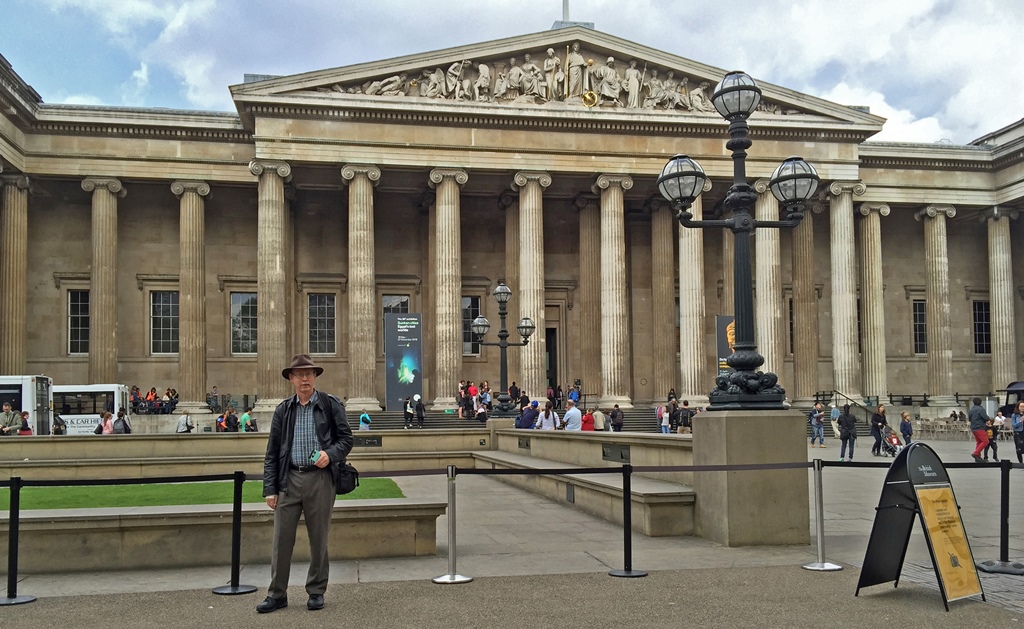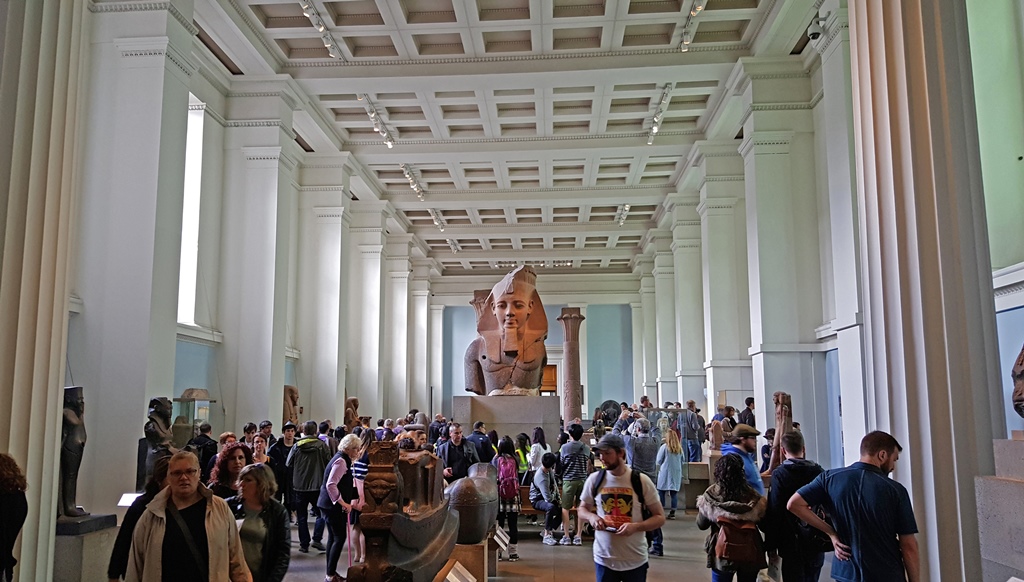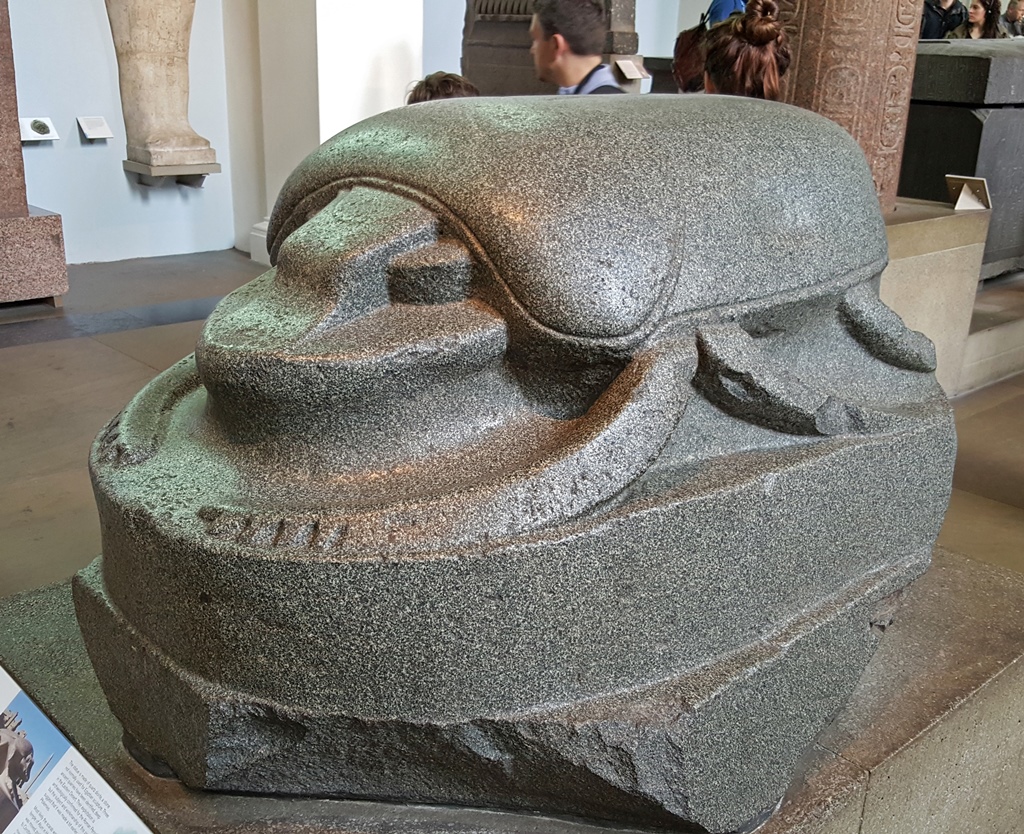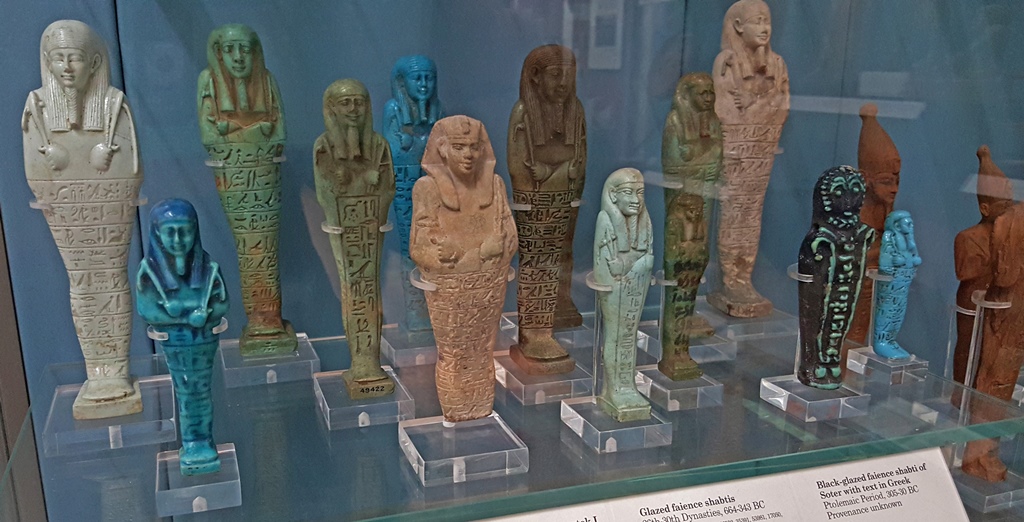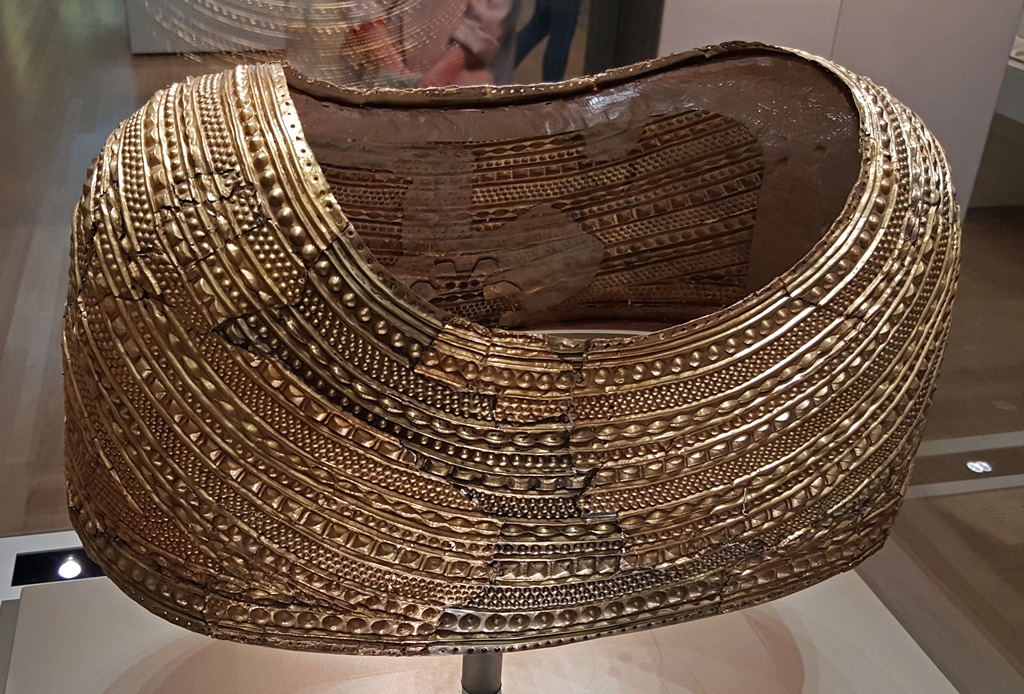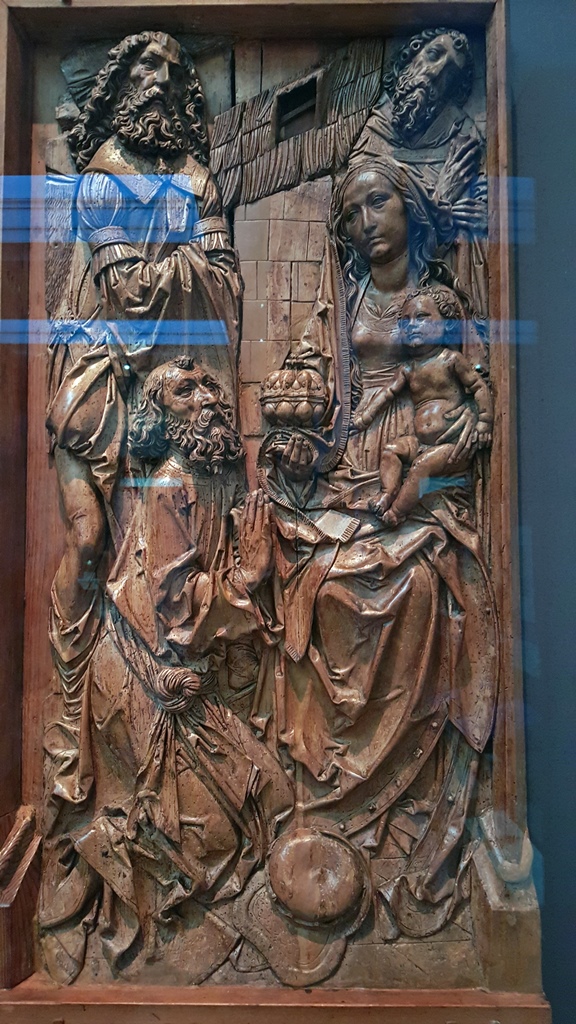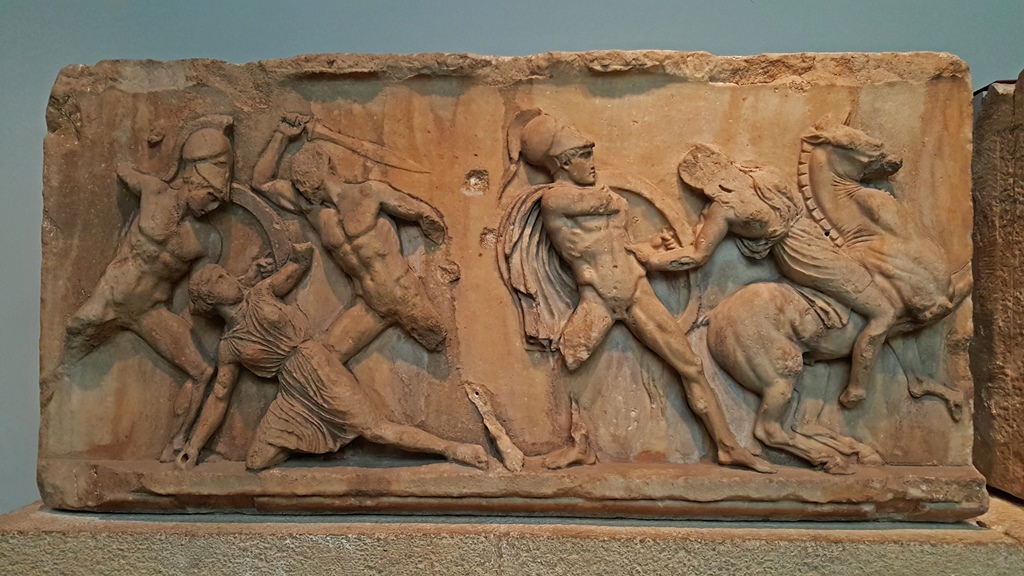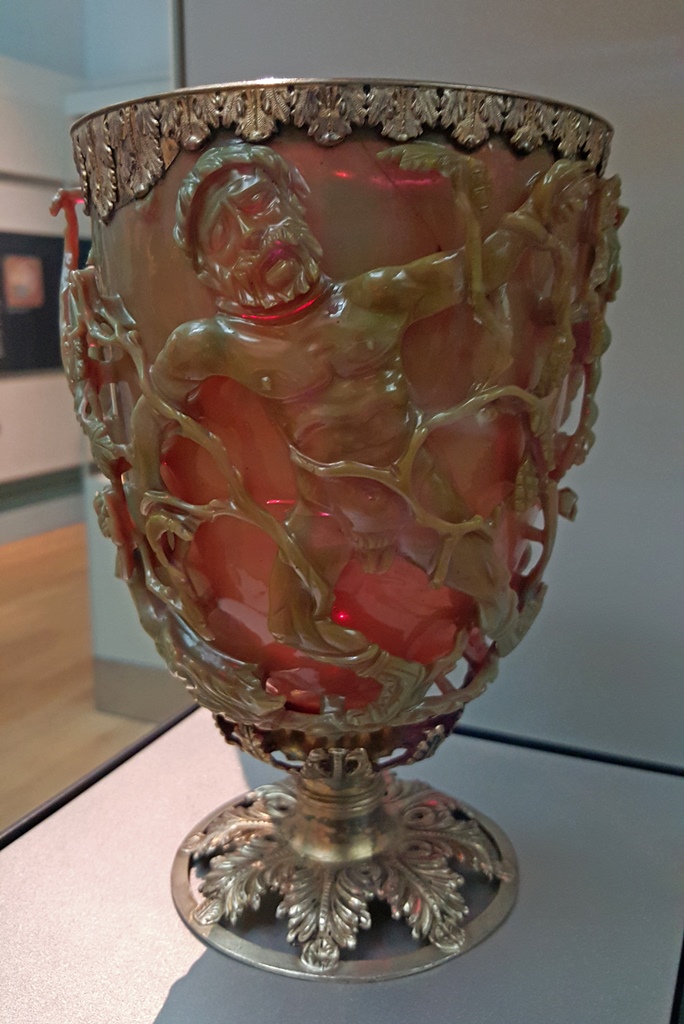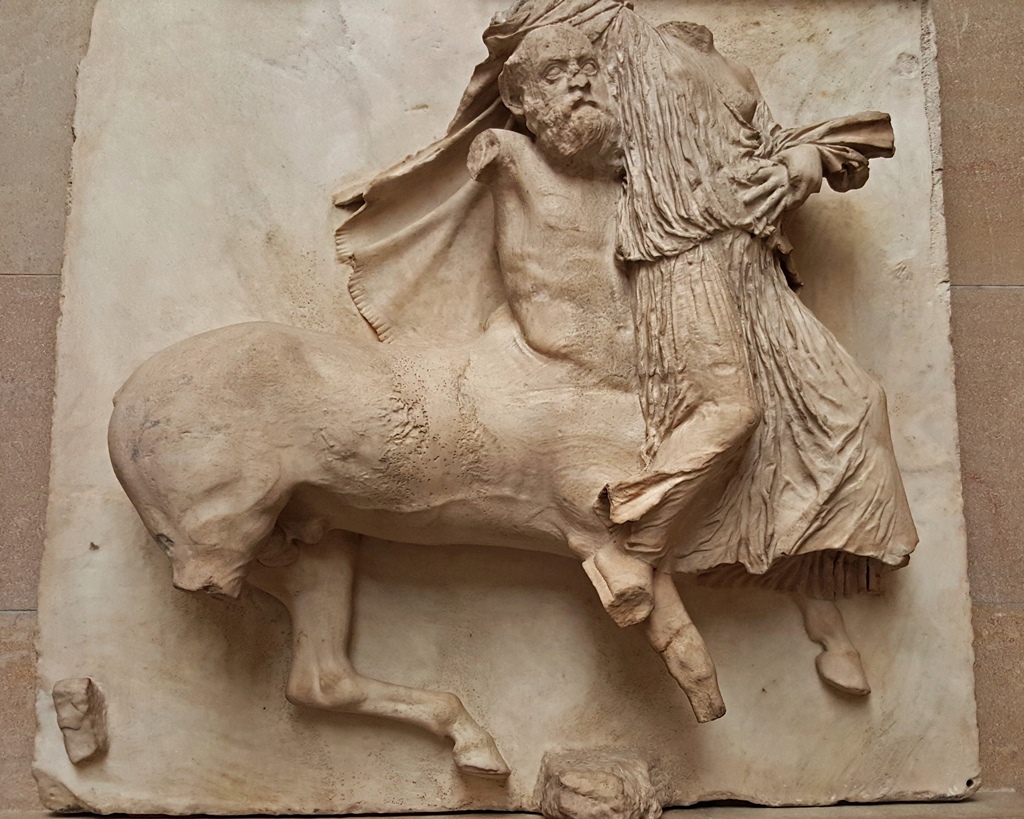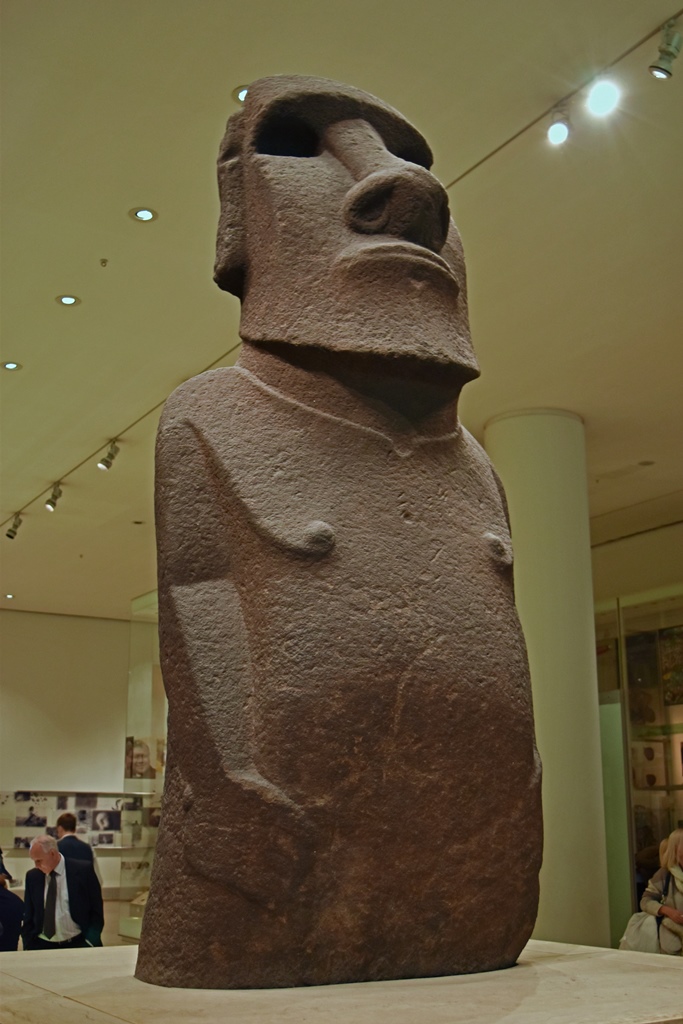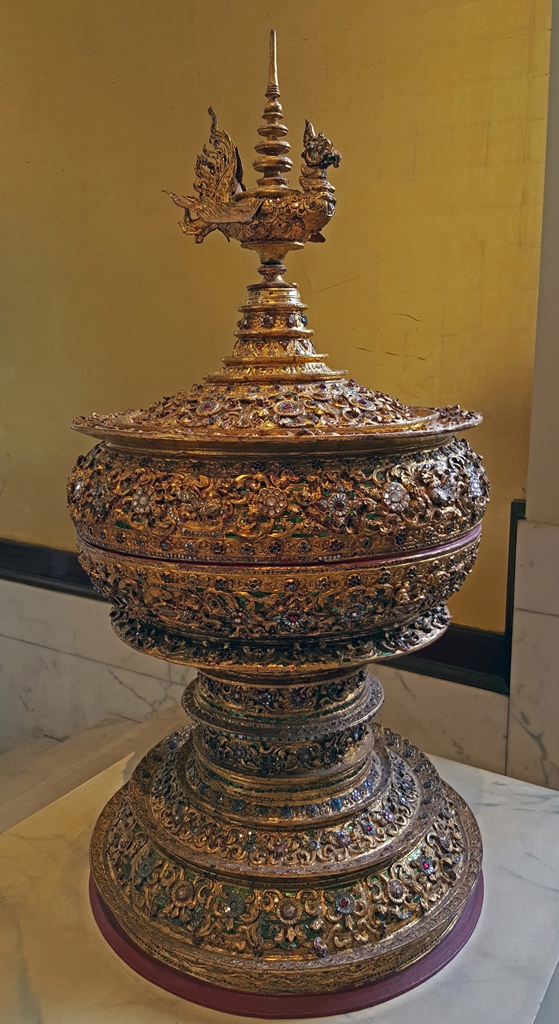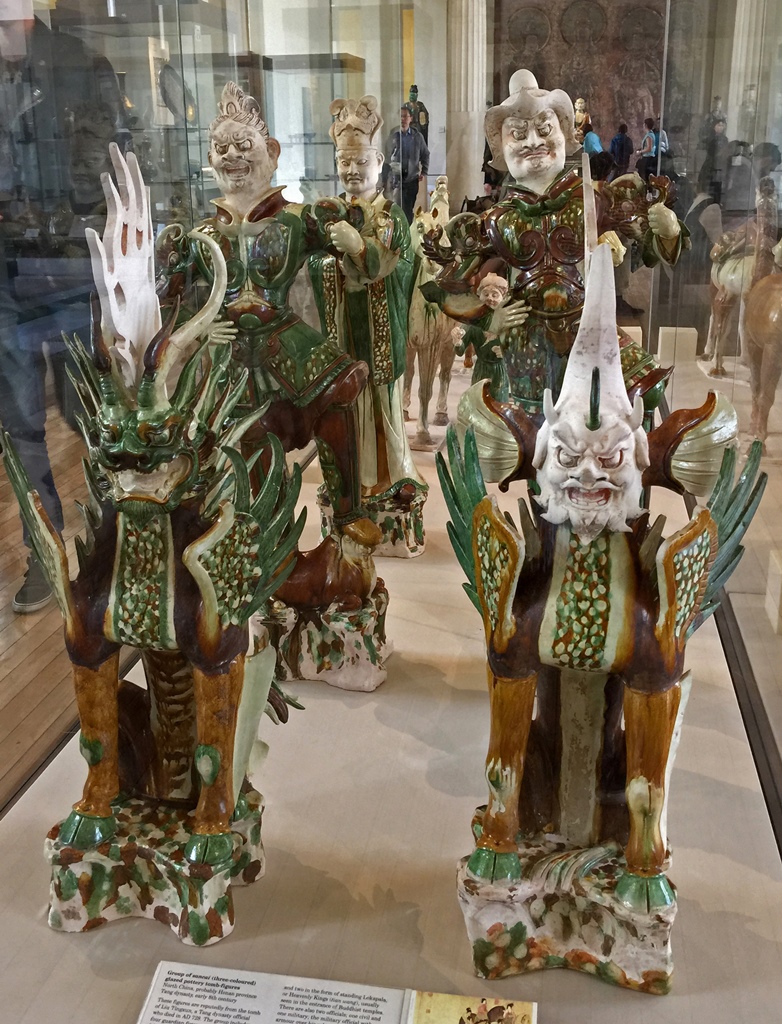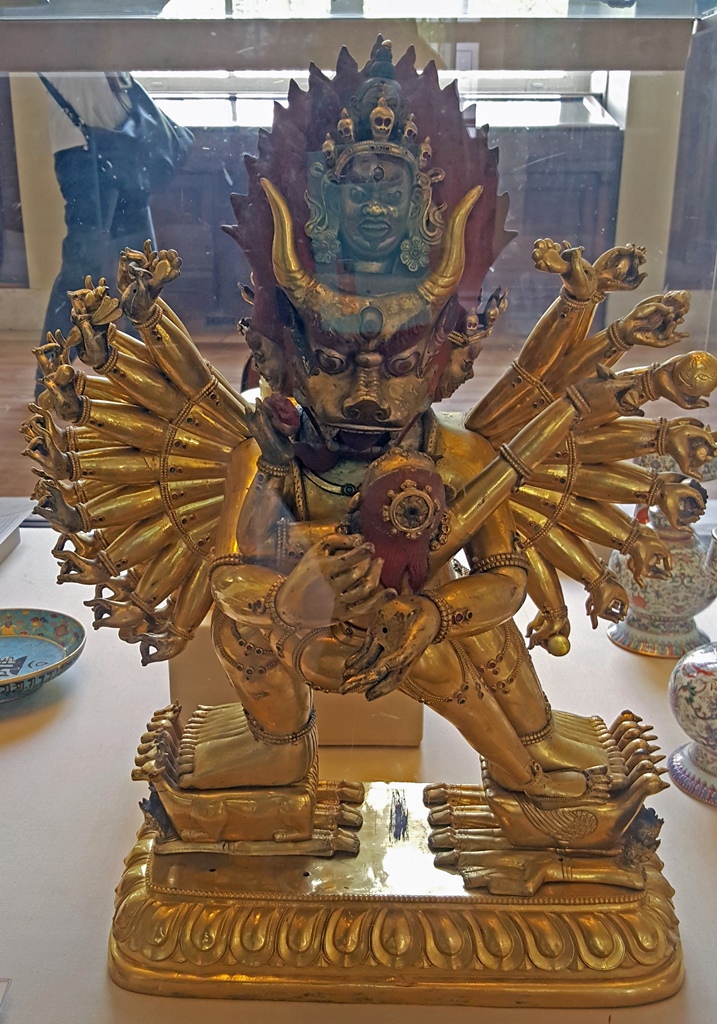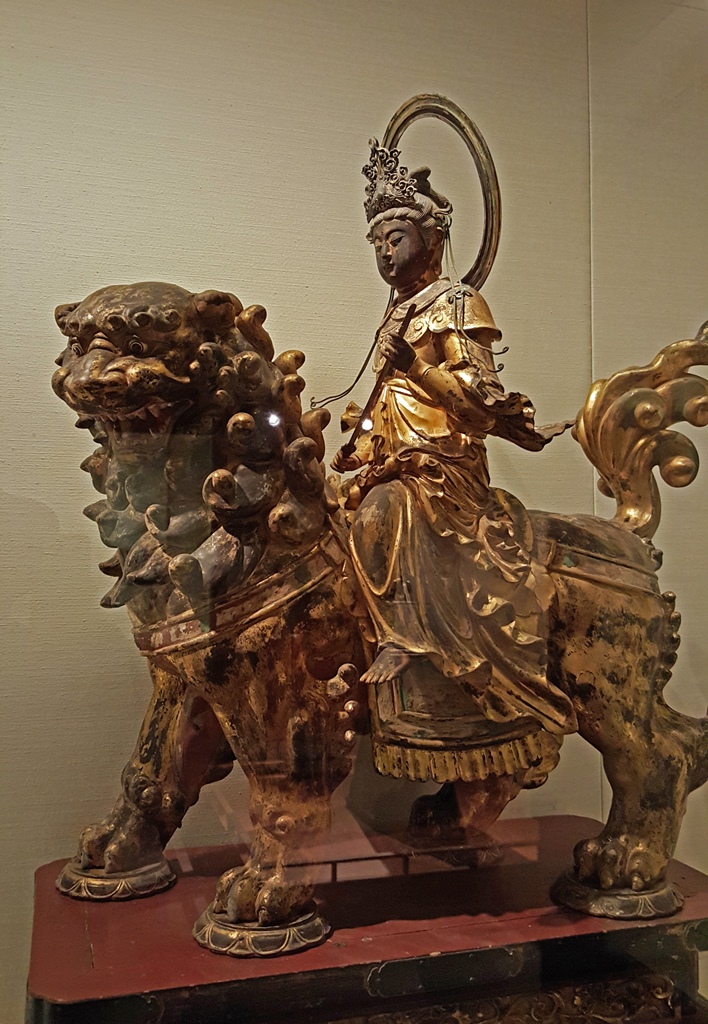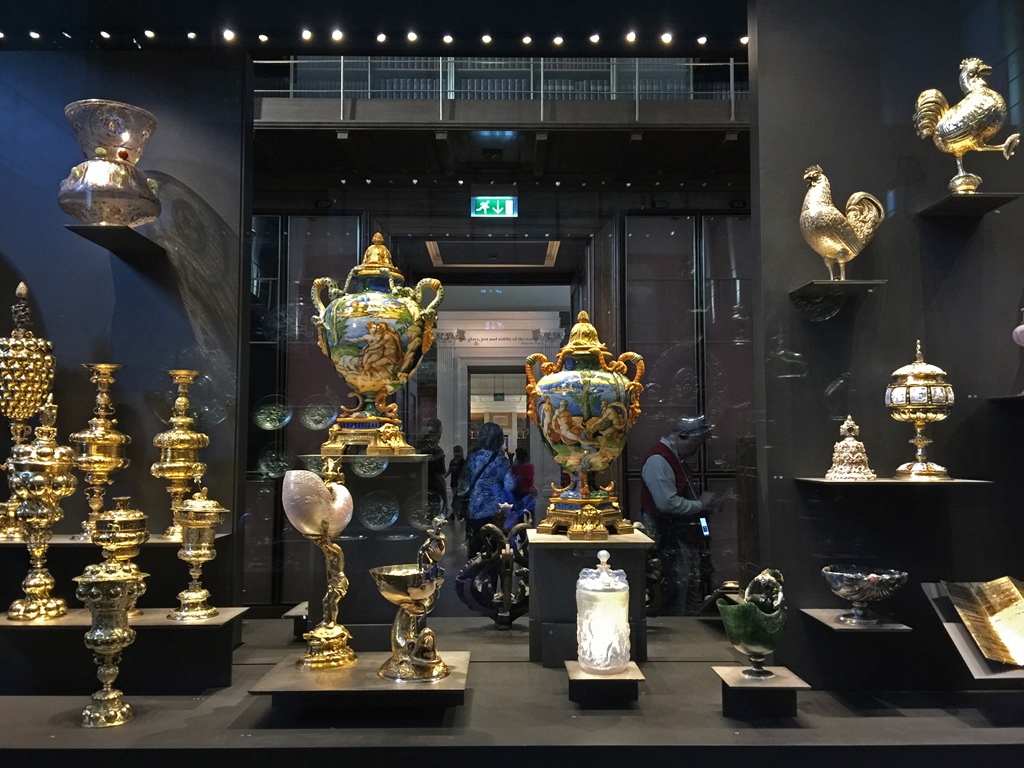Bob and British Museum
The British Museum is one of the world's
largest museums dedicated to human history and
culture. Its collection of roughly 13 million objects, mostly antiquities, was largely
acquired during the peak years of the British Empire, and is extraordinarily comprehensive.
When it was founded in 1753, it was envisioned as a repository for more universal subject
matter, including literature and natural history, and was opened in a former mansion, a
17th Century building called Montagu House. While Montagu House was large for a house, it
didn't take long for it to be overwhelmed by the growth of the museum's collections.
Plans for additional space were begun in 1802, but when George IV donated the
65,000-volume King's Library in 1822, it became clear that an expansion was urgently
needed. The architect Robert Smirke had been invited to come up with a redesign for the
museum in 1820, and his design was put into action starting in 1823. The plan was
ambitious and expensive, and was implemented in phases which did not complete until 1846.
The first phase was an eastern wing for accommodation of the Library, quickly followed by
a western wing, to be used for Egyptian antiquities.
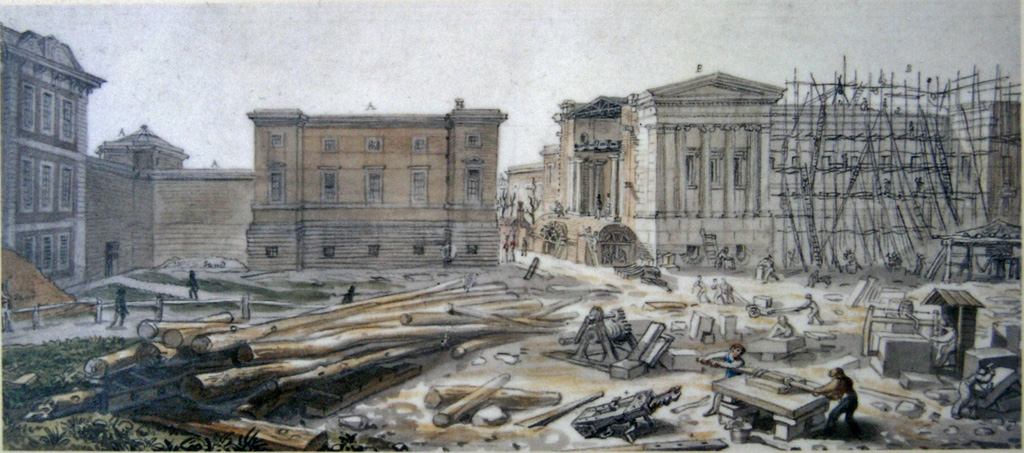
Smirke's West Wing Under Construction, 1828
The original plan called for a large rectangular neo-classical building, with a grand
courtyard in the middle. The courtyard was soon judged to be wasted space, so most of
it was filled with a structure for storage of books and manuscripts, with a large,
circular reading room in the center.
As you might expect, this "museum of everything" was pretty unwieldy, and big parts of
it eventually ended up as museums of their own. Space for a proposed gallery of
paintings was in fact never used for this purpose, as the separate National Gallery was
founded in 1824, which made this space available for other things (natural history
collections, at first). Then in 1881, a building in South Kensington was completed to
house the Natural History collection (this was still considered part of the British
Museum until 1962, when it became its own thing). And finally, the British Library was
created by Parliament in 1973 to house all the publications, though an actual building
for this purpose (in the St. Pancras area) was not completed until 1997. This left the
British Museum as a much more specialized institution - but it's still really full of
stuff, as you'll see.
The British Museum was actually within an easy walk of our hotel. To get in, we had to
go through a checkpoint, but after that we were able to go right in. Admission was
free, and photography without flash was OK. The center of things is the Great Court,
which was opened up again after all the books were removed. The Reading Room remains
as a large cylindrical building which is now used for temporary exhibitions (our visit
was between exhibitions). The rest of the Great Court is again open space, but there's
now a glass roof covering the whole thing.

In the Great Court
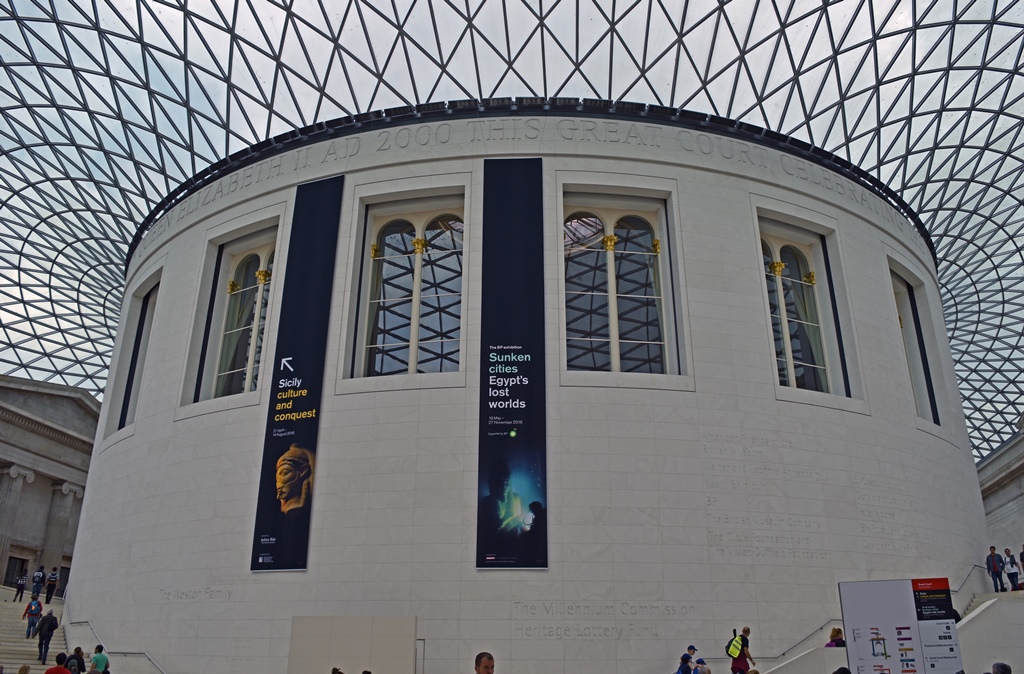
The Reading Room
The courtyard is a space from which visitors can quickly get to any part of the museum.
We chose to first head for the western part of the museum, which turned out to have ancient
Egyptian displays. The first display we saw on the way in was the Rosetta Stone. Yes, the
actual Rosetta Stone. The stone dates back to 196 B.C., and was found in 1799 by a French
soldier during Napoleon's Egyptian campaign, near the town of Rosetta (or Rashid), in the
Nile delta. The British defeated the French in this campaign, in 1801, and took the stone
from them. The stone displays the text of a Ptolemaic decree in three different written
languages: hieroglyphics, Demotic script (a character-based version of Egyptian) and Greek.
As of 1799, nobody had been able to decipher ancient Egyptian hieroglyphics, but Greek was
well-known. The stone gave researchers a previously-unknown way to understand the
inscriptions with which ancient Egyptian tombs, temples and artifacts were covered, and
opened up a whole new understanding of ancient Egypt.
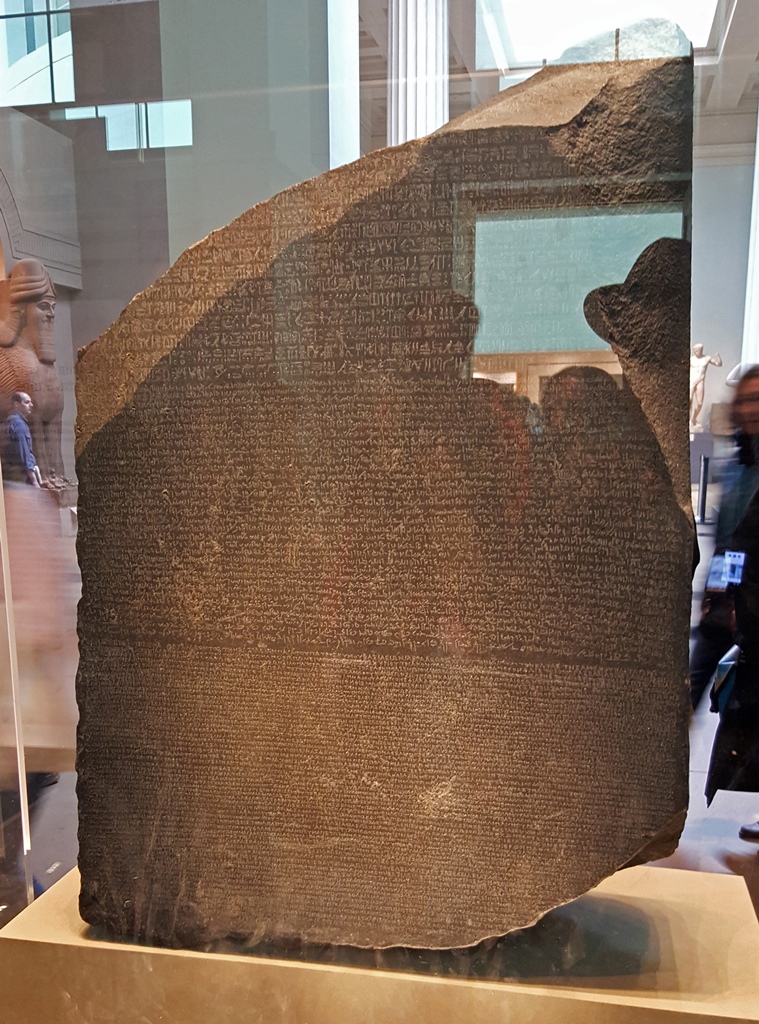
The Rosetta Stone (196 B.C.)
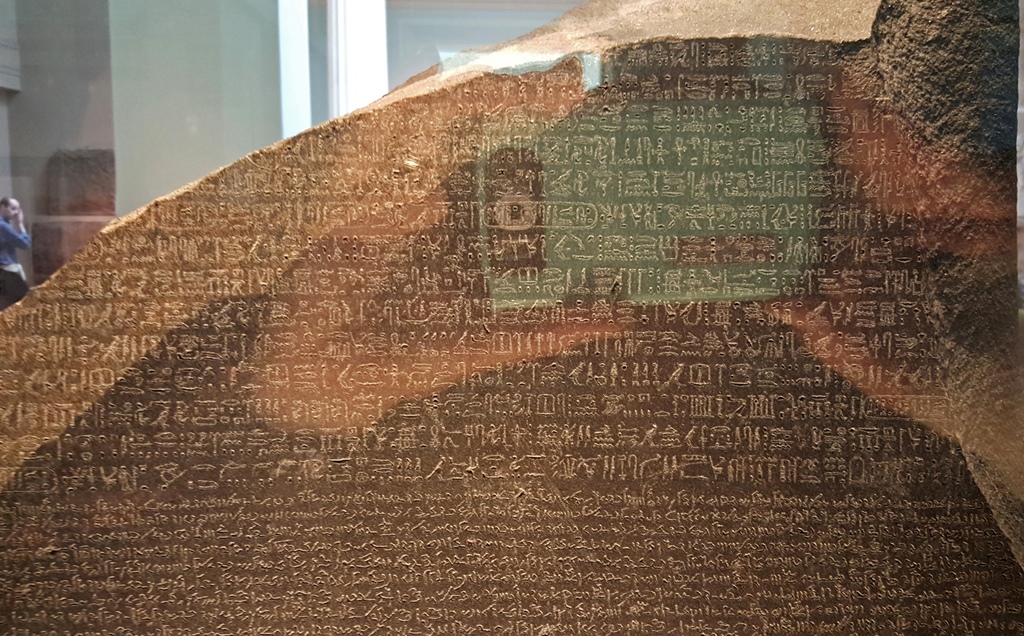
Rosetta Stone Detail (Hieroglyphic and Demotic Sections)
Just past the Rosetta Stone was a large room with displays of Egyptian sculpture.
Egyptian Gallery
The British Museum has a large collection of Egyptian artifacts, in fact the largest
collection of Egyptian antiquities in the world, except for the Egyptian Museum in Cairo
(currently in the process of transitioning to the new Grand Egyptian Museum, across the
river in Giza). In order to impose some order on the following pictures, I'll present
them roughly chronologically, divided by recognized periods of Egyptian history. Since
Egyptian history goes back more than 5,000 years, it has a lot of recognized periods. A
few whose names you might recognize are the Old, Middle and New Kingdoms (the terms are
relative - the "New Kingdom" ended more than 3,000 years ago). But there is also a
period before the Old Kingdom, "intermediate periods" between the kingdoms and several
periods more recent than the New Kingdom. Fortunately our pictures are from only a few
of these periods, so this shouldn't be too complicated.
First, here's our only picture of a Middle Kingdom artifact. The Middle Kingdom lasted
from 2055 through 1650 B.C. It's not clear exactly where in Egypt this boat model came
from (it was purchased from a private collection), but it's typical of objects which
were encased in tombs along with the deceased.
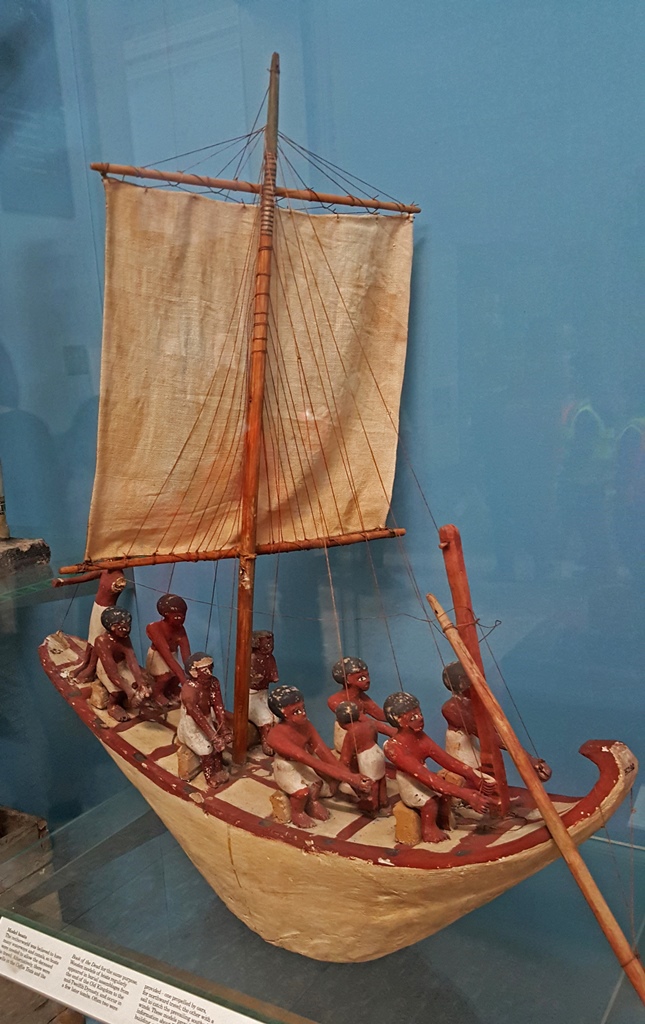
Model of a Boat (ca. 1985-1795 B.C.)
This next group of photos is of objects from the New Kingdom, which lasted from 1550
through 1069 B.C. (there was a 100-year Intermediate Period between the Middle and New
Kingdoms). This was the period of the most famous pharaohs (Thutmose III, Amenhotep III,
Ramesses II, Tutankhamun) and many famous tombs and monuments. The beard of the Sphinx
was likely an add-on by Thutmose IV (the Sphinx is much older, dating back to the Old
Kingdom) that fell off at some point. The New Kingdom is also when the Book of the Dead
came into use. There were many versions of the Book of the Dead, which were buried with
the deceased and contained information and magic spells to assist them in the underworld.
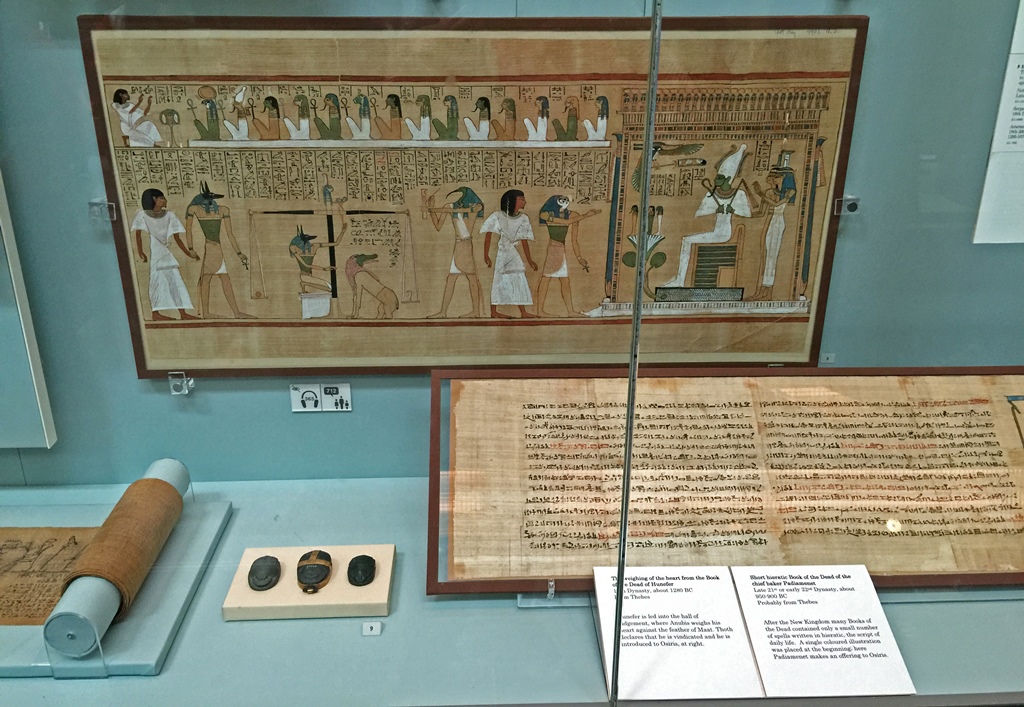
Book of the Dead with Weighing of the Heart
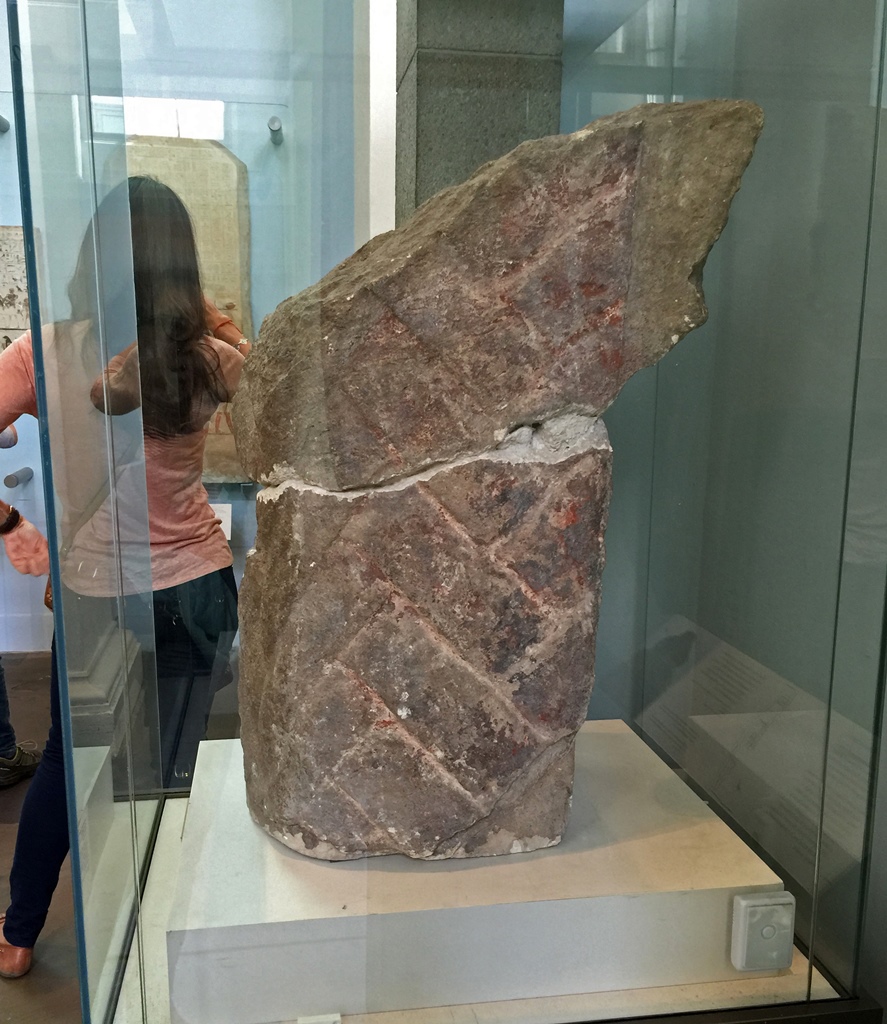
Fragment of the Beard of the Sphinx, Giza (ca. 1420 B.C.)
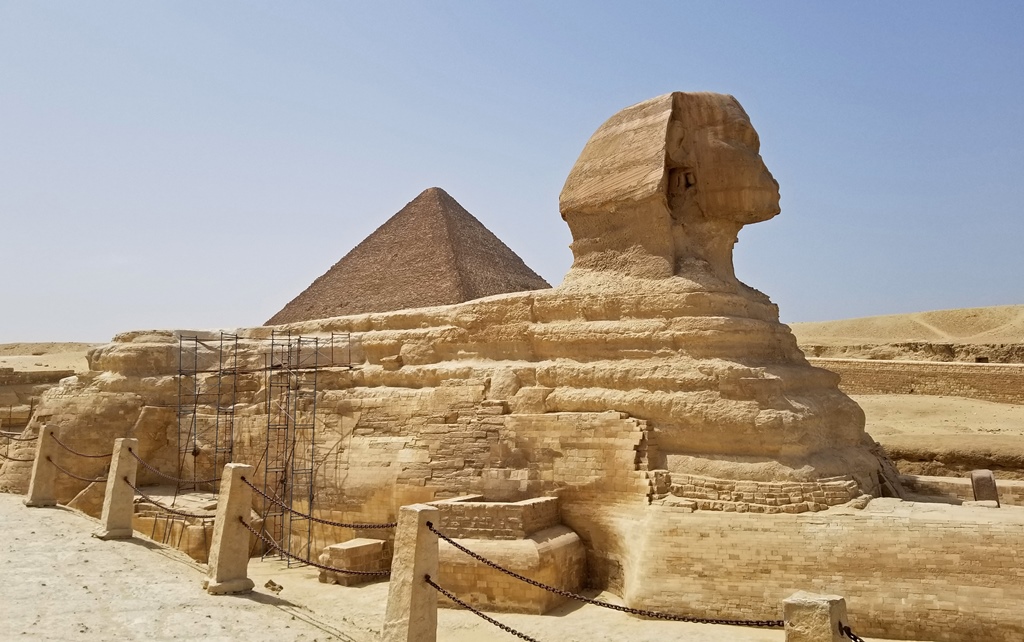
Great Sphinx of Giza and Pyramid of Cheops (2019 photo)
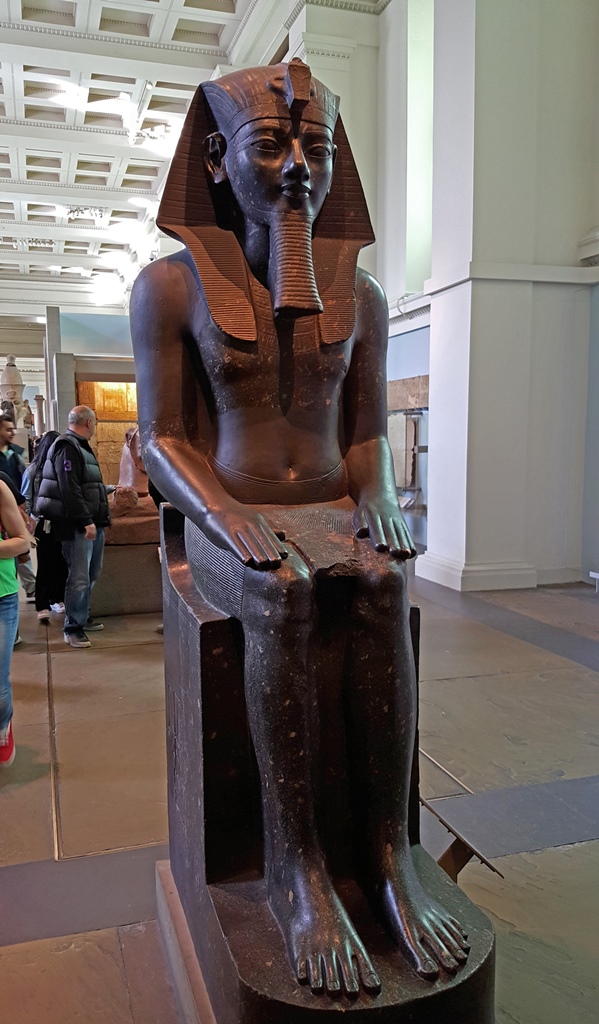
King Amenhotep III, Thebes (ca. 1390-1352 B.C.)
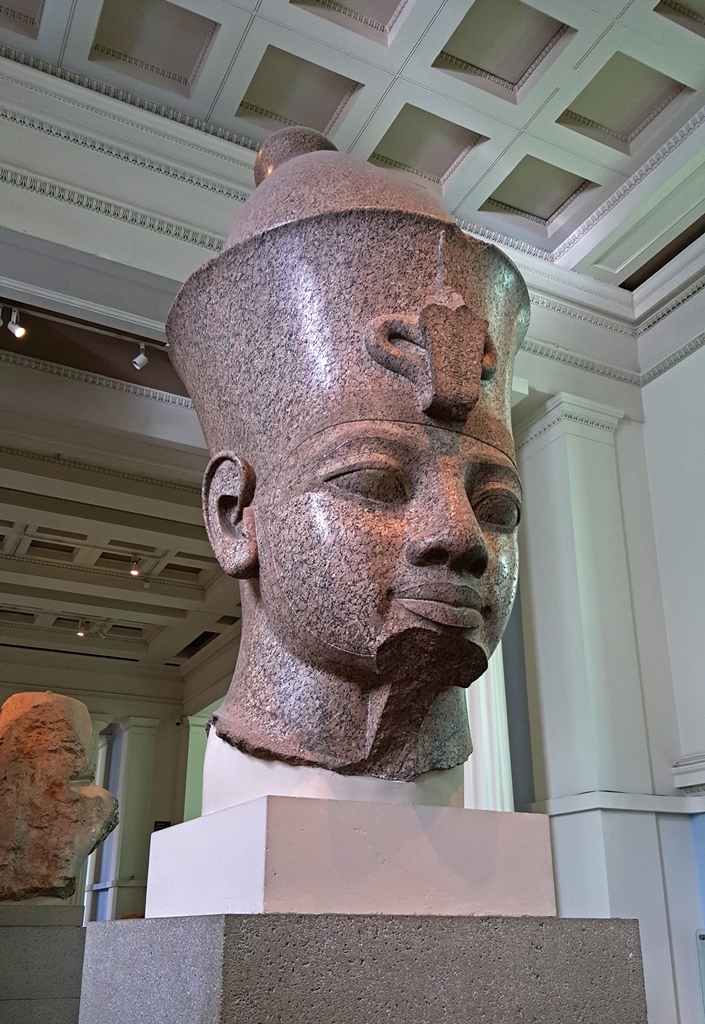
Amenhotep III, Karnak (ca. 1390-52 B.C.)
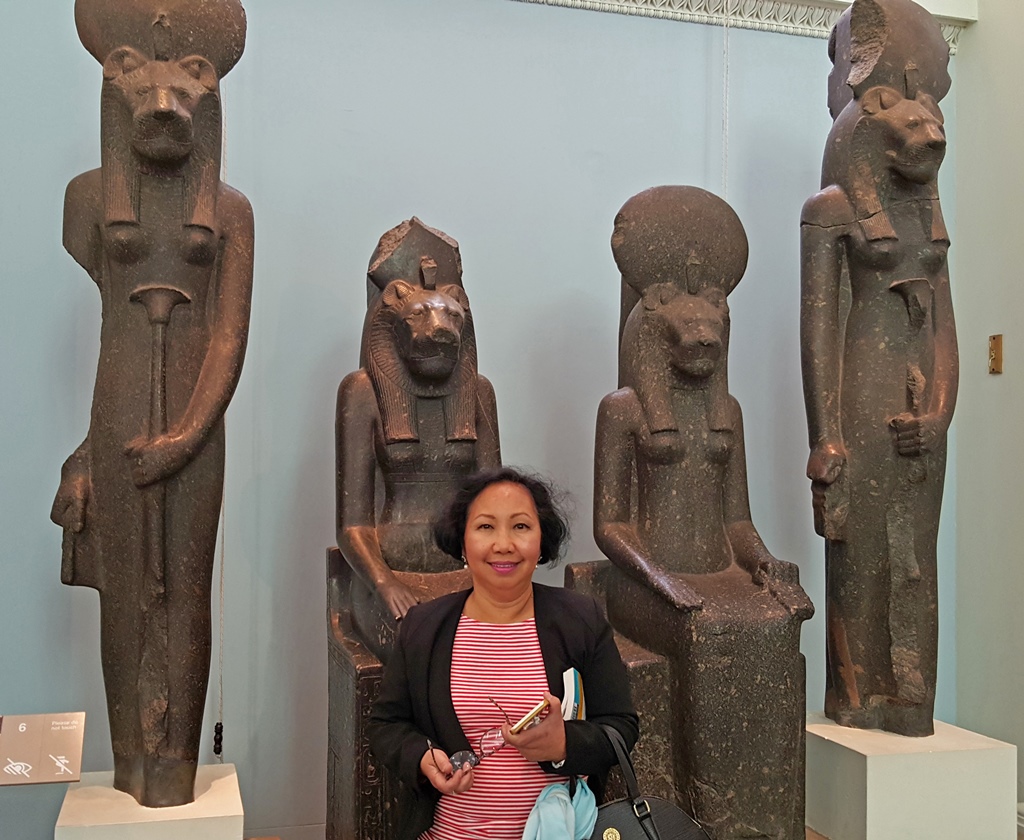
Nella with Statues of Sekhmet, Karnak (ca. 1390-52 B.C.)
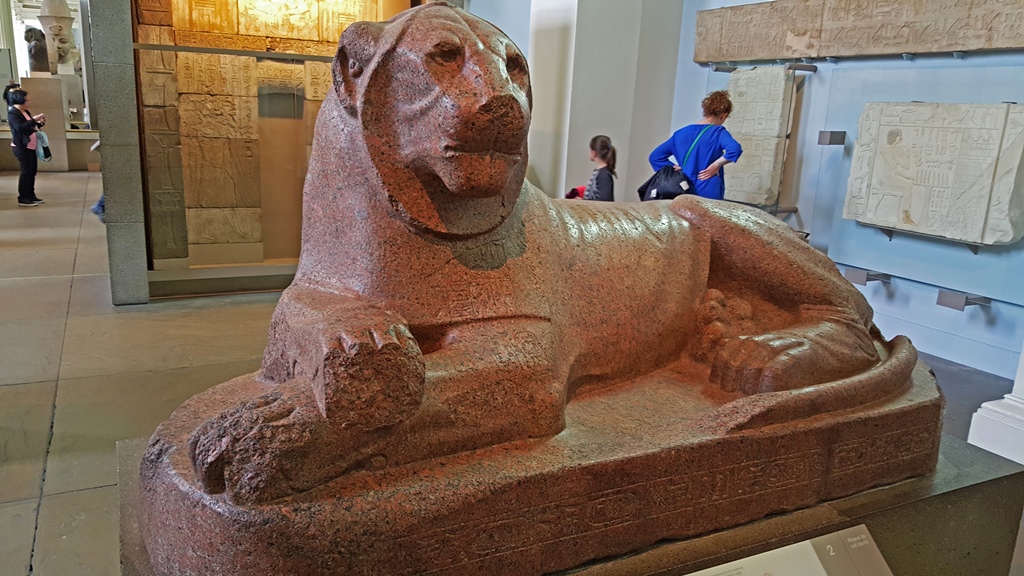
Amenhotep III as a Lion, Sudan (ca. 1390-1352 B.C.)
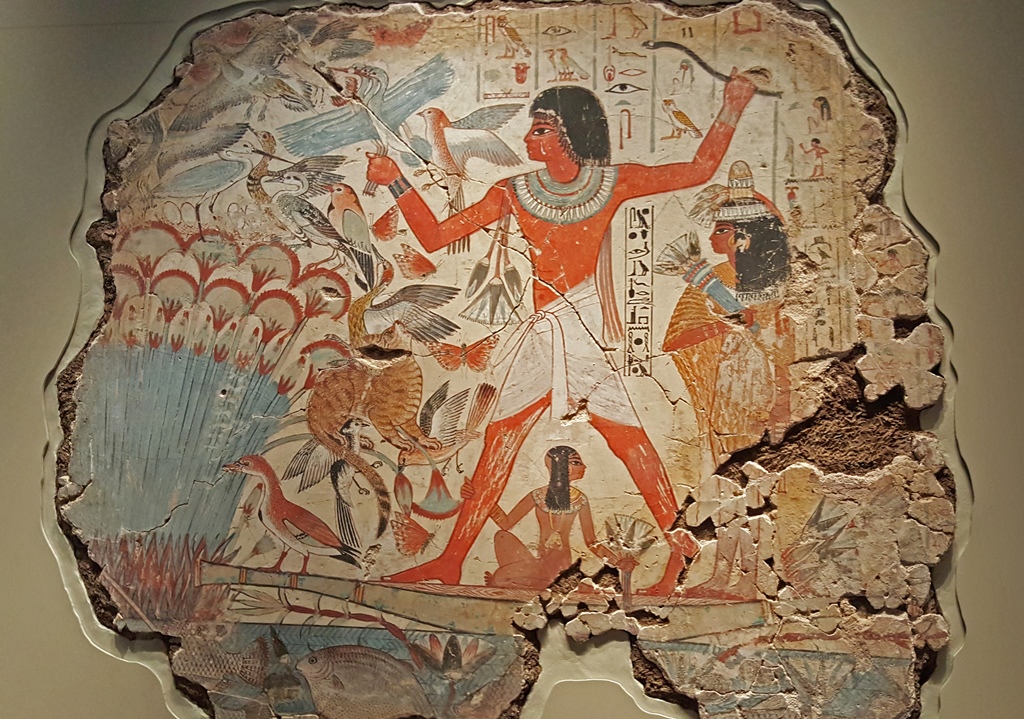
Nebamun Hunting in the Marshes, Thebes (ca. 1350 B.C.)
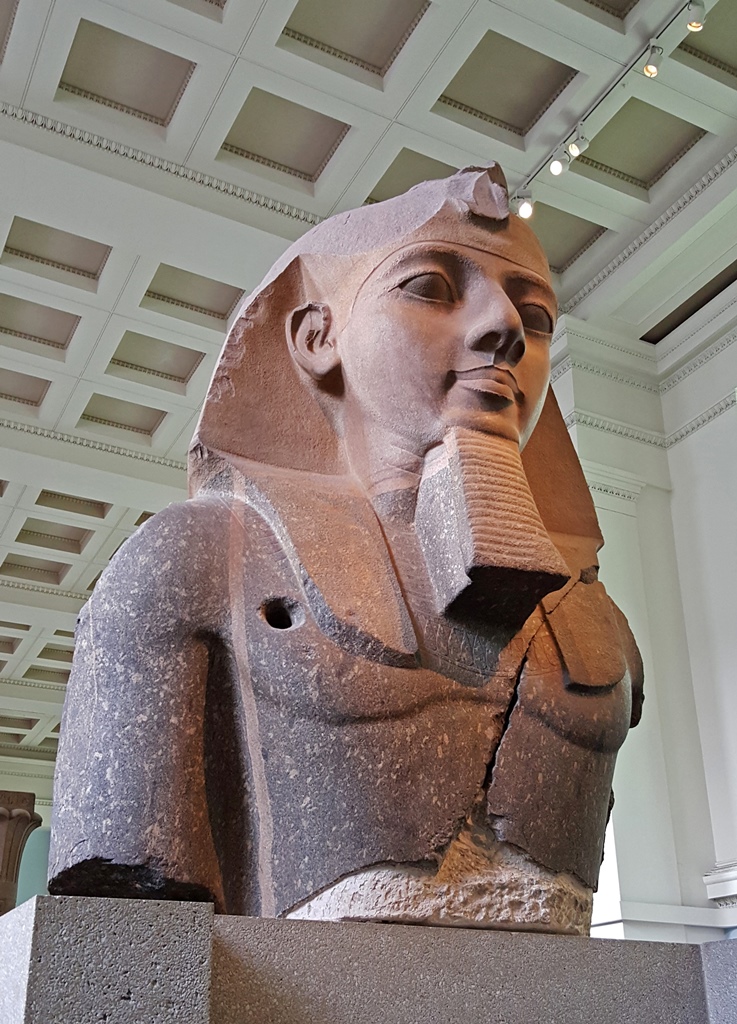
Rameses II Statue, Thebes (ca. 1279-1213 B.C.)
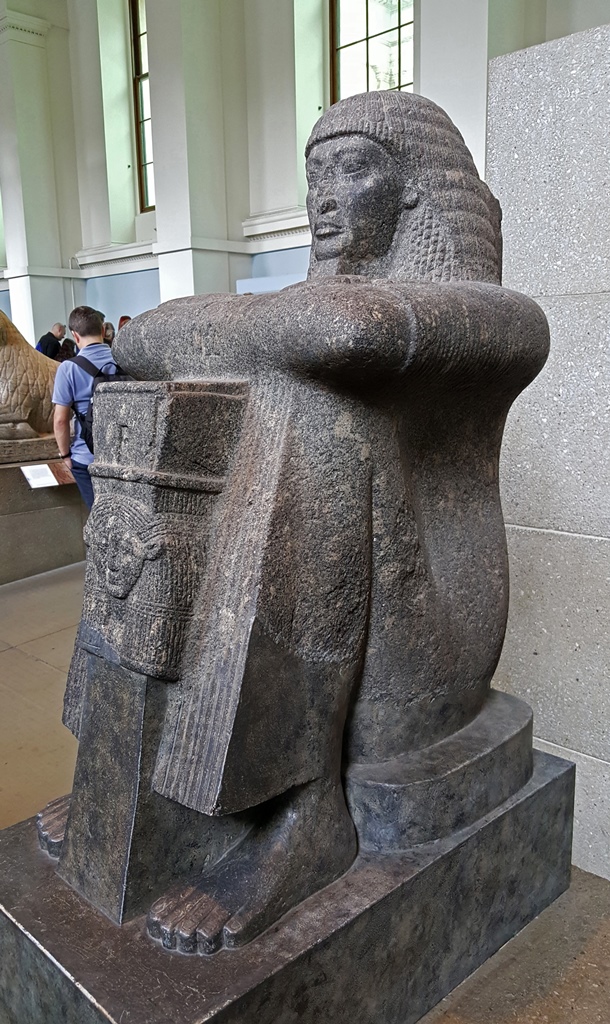
Roy (High Priest of Amun-Ra), Thebes (ca. 1220-1200 B.C.)
After the New Kingdom, there was a 400-year intermediate period that lasted until 664 B.C.
You'd think a period lasting 400 years would rate a better name than "intermediate", but I'm
not an Egyptologist. Anyway, here are a couple of items from the Third Intermediate Period:
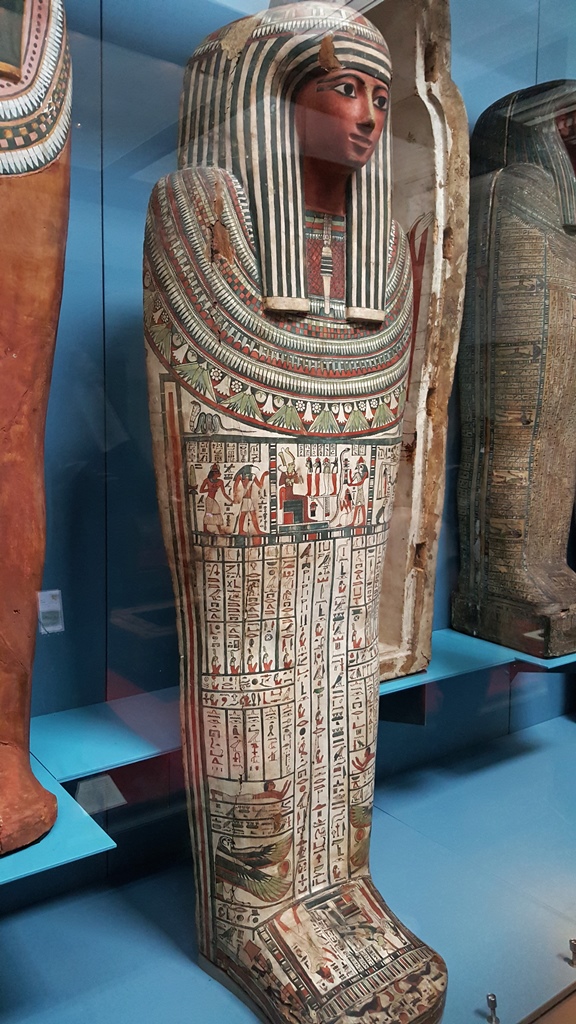
Coffin of the Priest of Khons, Nespernebu, Thebes (ca. 800 B.C.)
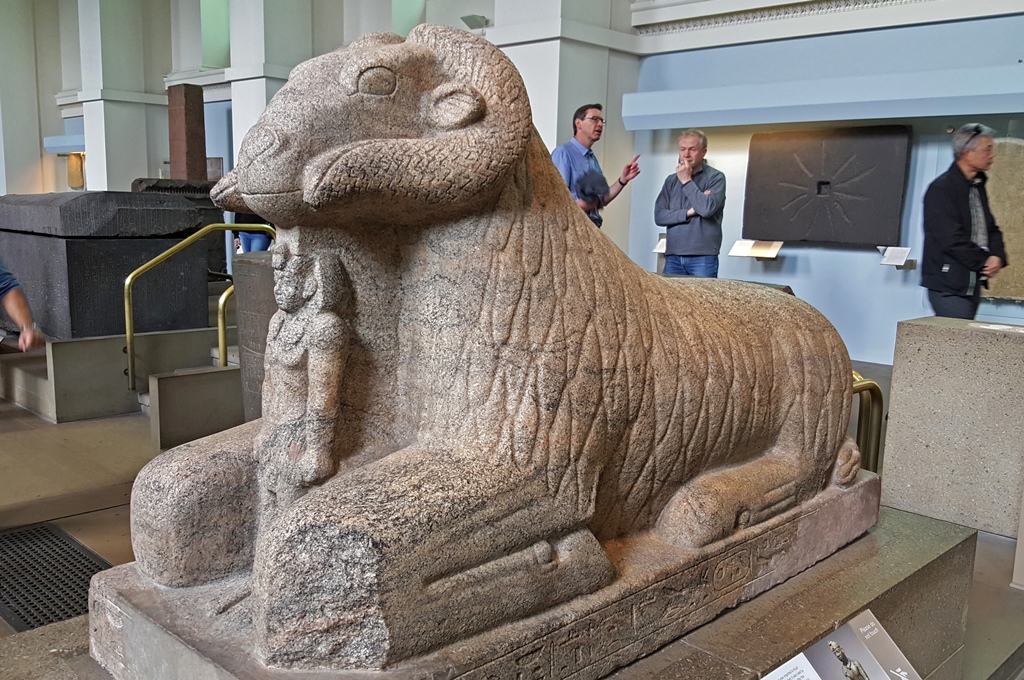
Ram Sphinx of King Taharqo, Sudan (690-664 B.C.)
This gave way to the Late Period, which lasted until 332 B.C.:
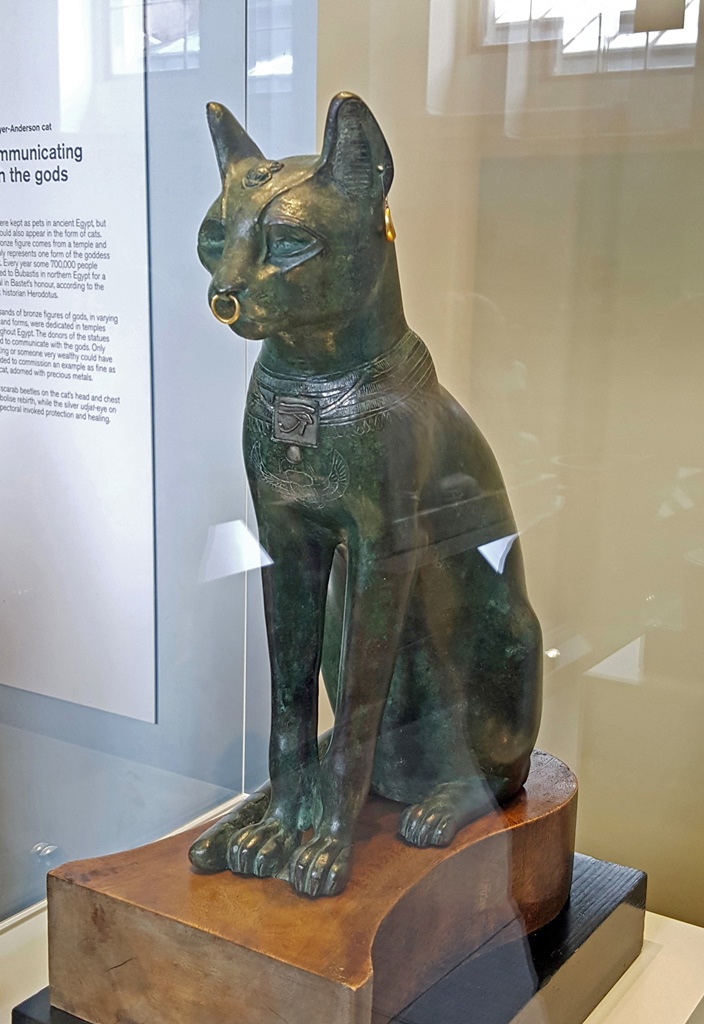
The Gayer-Anderson Cat, Saqqara (ca. 600 B.C.)
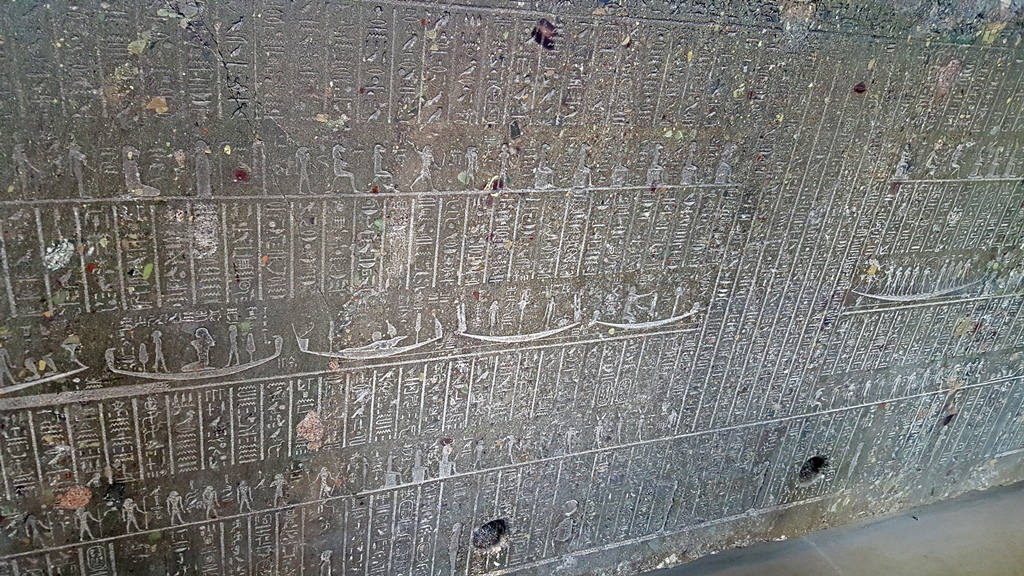
Detail, Sarcophagus of Nectanebo II, Alexandria (360-343 B.C.)
The last period represented in our pictures began with the reign of Alexander the Great,
who conquered Egypt in 332 B.C. After Alexander died in Babylon in 323 B.C., his empire
started to crumble, and there were disputes over succession in various parts of it,
including Egypt. Relatives and friends of Alexander were involved in the Egypt dispute,
and the eventual victor was Alexander's friend Ptolemy, who took the title of Pharaoh
Ptolemy I. This began the Ptolemaic Dynasty, which would continue until 30 B.C., at which
time it would end with the death of the last Ptolemaic ruler, Cleopatra VII. This whole
period is called the Ptolemaic Kingdom, and here's a picture of a giant bug from this period:
Colossal Scarab, Heliopolis (3rd-2nd C. B.C.)
One last picture of Egyptian artifacts shows shabtis from various periods. Shabtis
were small figures that were commonly placed in tombs, beginning way back during the Old
Kingdom, that were expected to become animated and perform manual labor when the deceased
needed them.
Assorted Shabtis
Moving on from Egypt, we found rooms of artifacts from ancient Britain and Ireland. One
such artifact was a Bronze Age gold cape, which was thoroughly restored by the museum
after it was found in Wales in 1833:
Gold Cape, Wales (ca. 1900-1600 B.C.)
Here are more artifacts, some of which go back to Roman days:
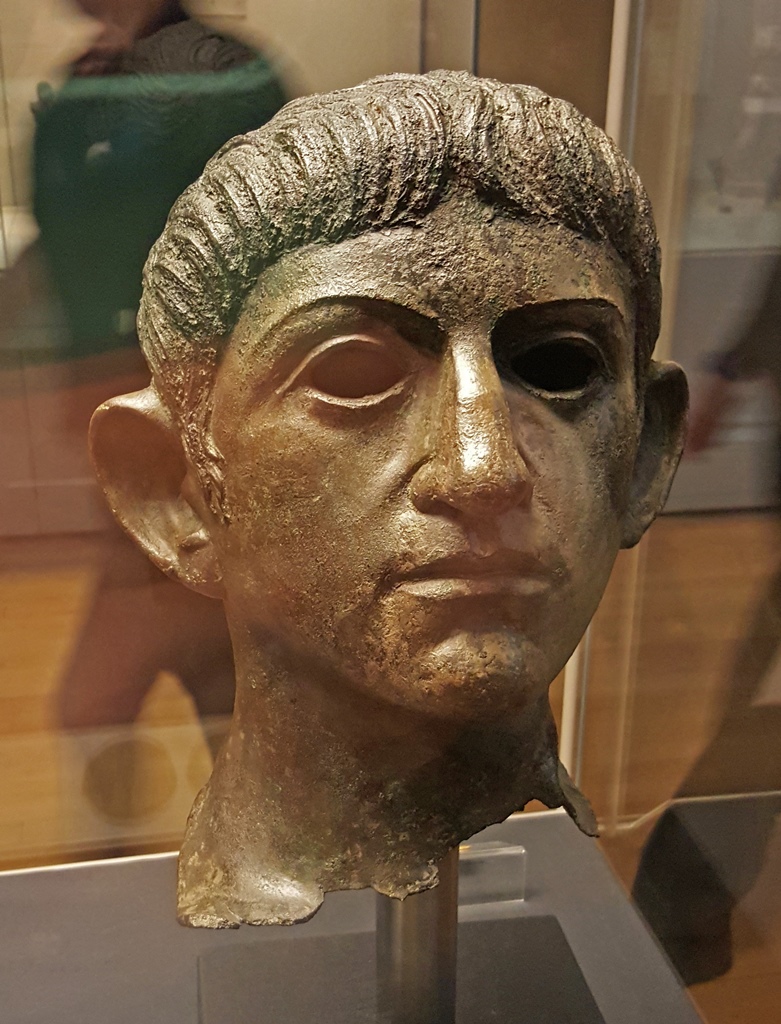
Bronze Head of Claudius, Suffolk (1st C. A.D.)
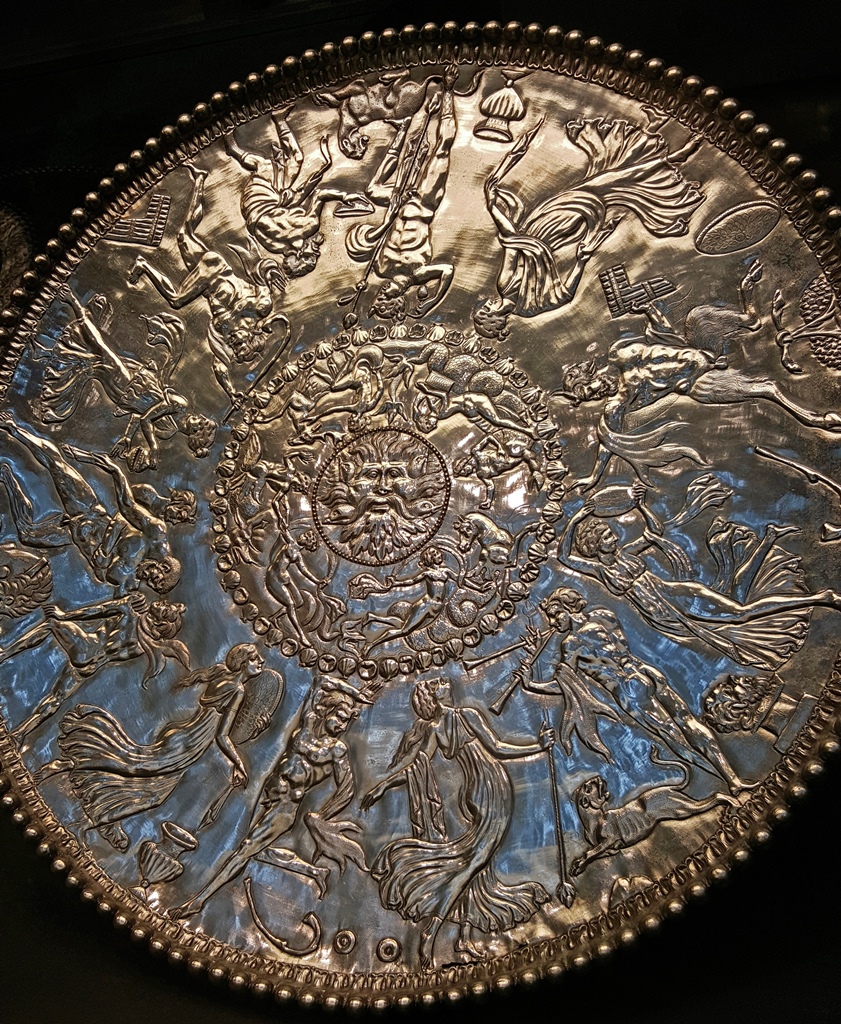
The Mildenhall Great Dish, Suffolk (4th C. A.D.)
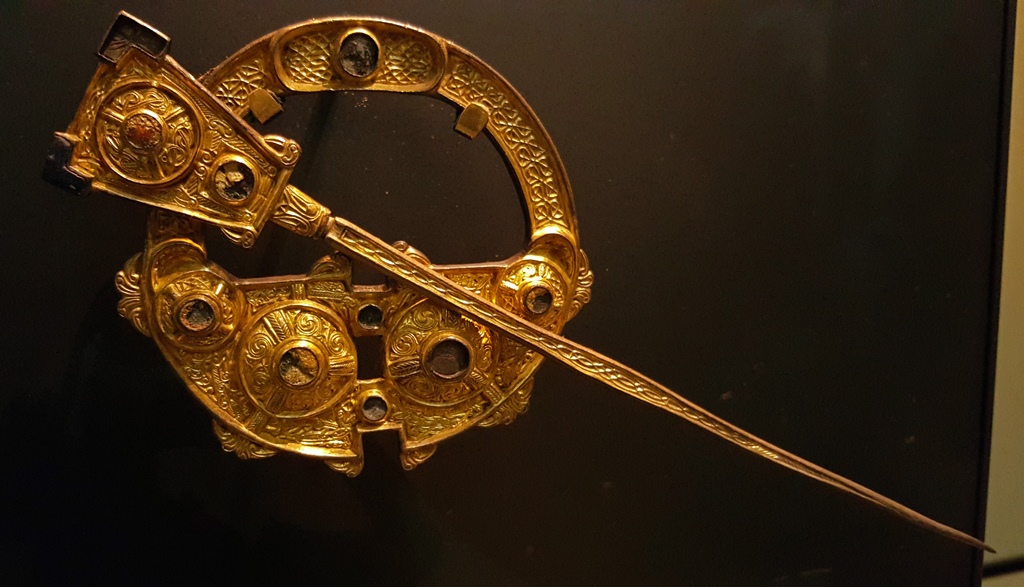
The Londesborough Brooch, Ireland (8th-9th C.)
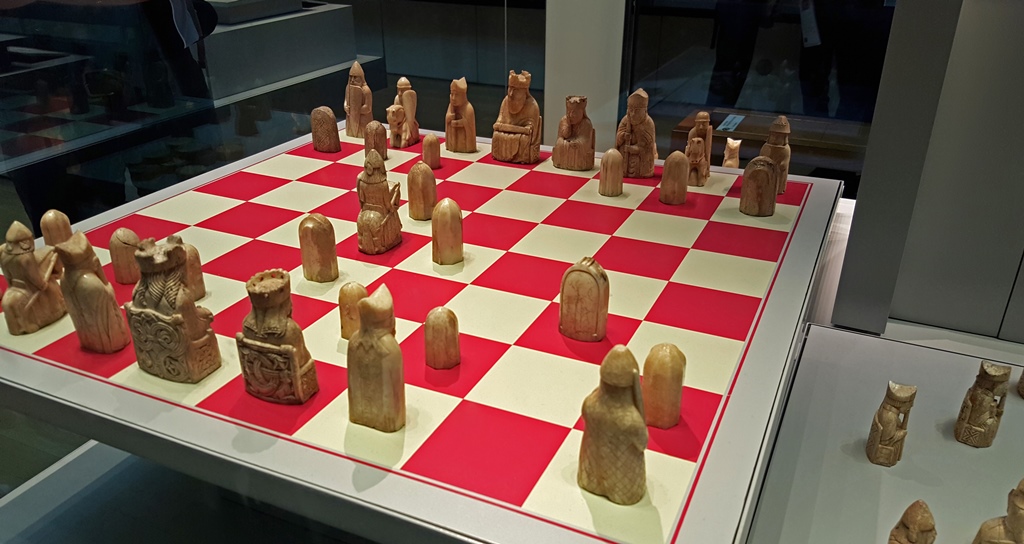
The Lewis Chessmen, Scotland (12th C.)
There were also some decorative objects from the 18th Century, which seemed as though
they would be more at home in the collection of the Victoria and Albert Museum. But
they were in the British Museum instead, and here are a few of them:
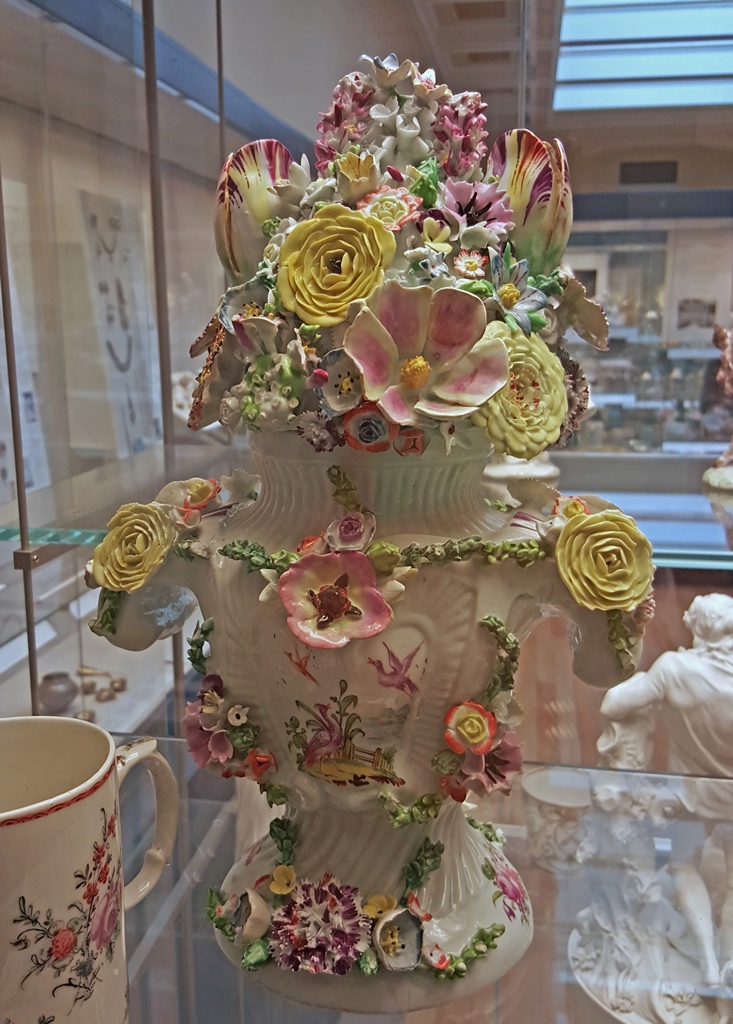
Porcelain Vase and Cover, William Littler's Factory (ca. 1755)
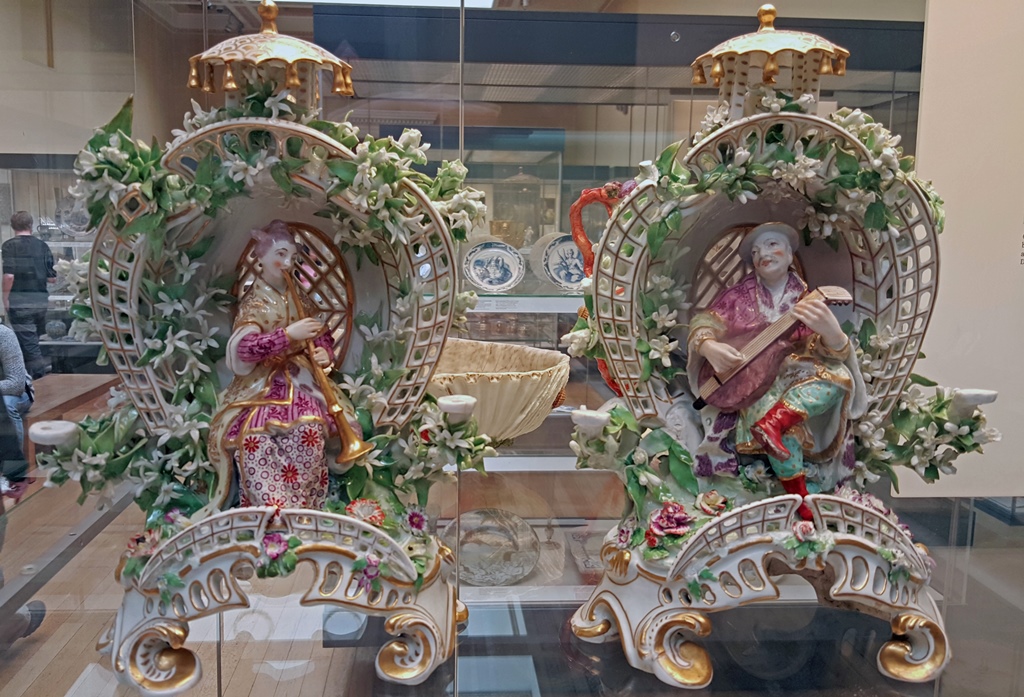
Pair of Musicians in Arbours, Chelsea Factory (ca. 1758-69)
Musical Table Clock with Automata, Stephen Rimbault (ca. 1765)
There were also some religious objects from continental Europe, and here are a few of those:
The Adoration of the Three Wise Men, Tilman Riemenschneider (ca. 1505-10)
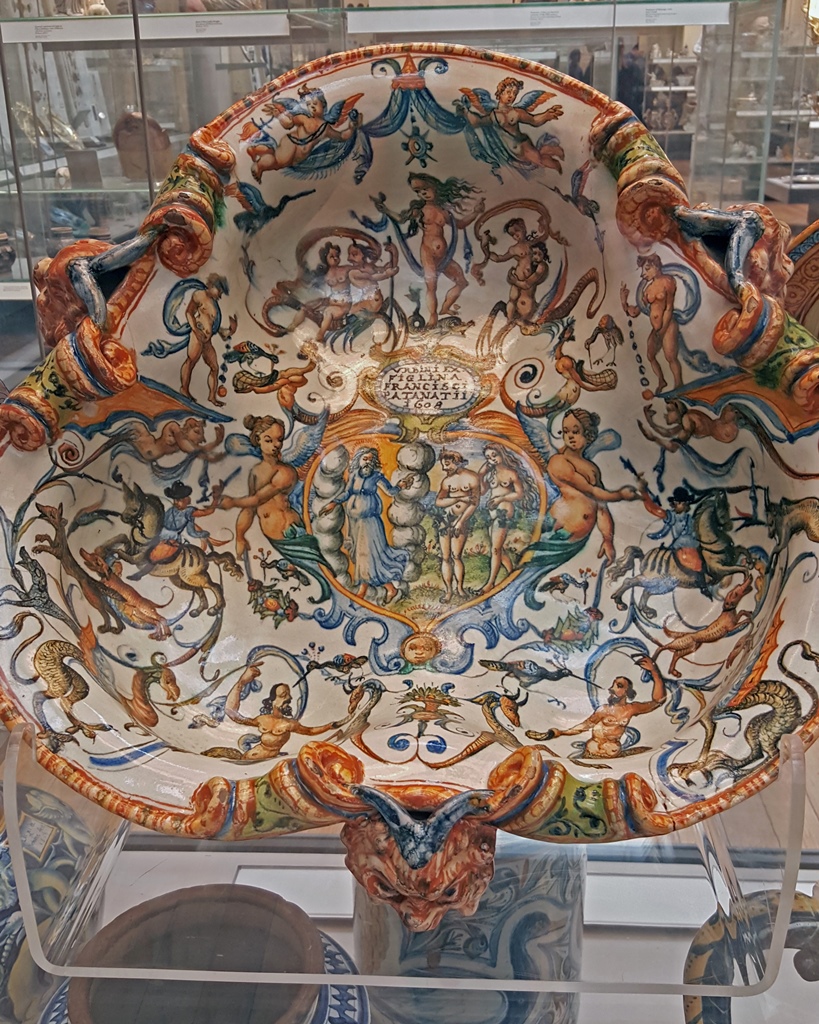
Adam and Eve Chastised by God, Urbino (1608)
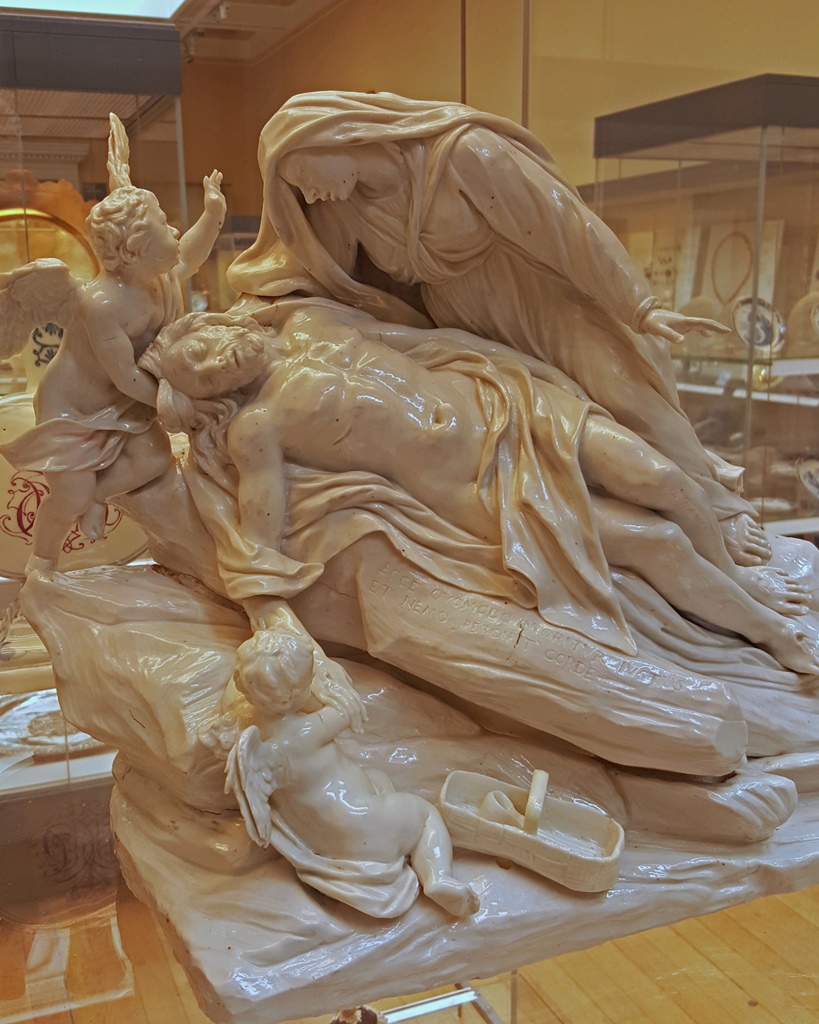
Lamentation Over the Dead Christ, Doccia Factory, Florence (ca. 1750)
Moving back to the first millennium B.C., here are some objects from Assyria, which was
located in present-day Iraq:
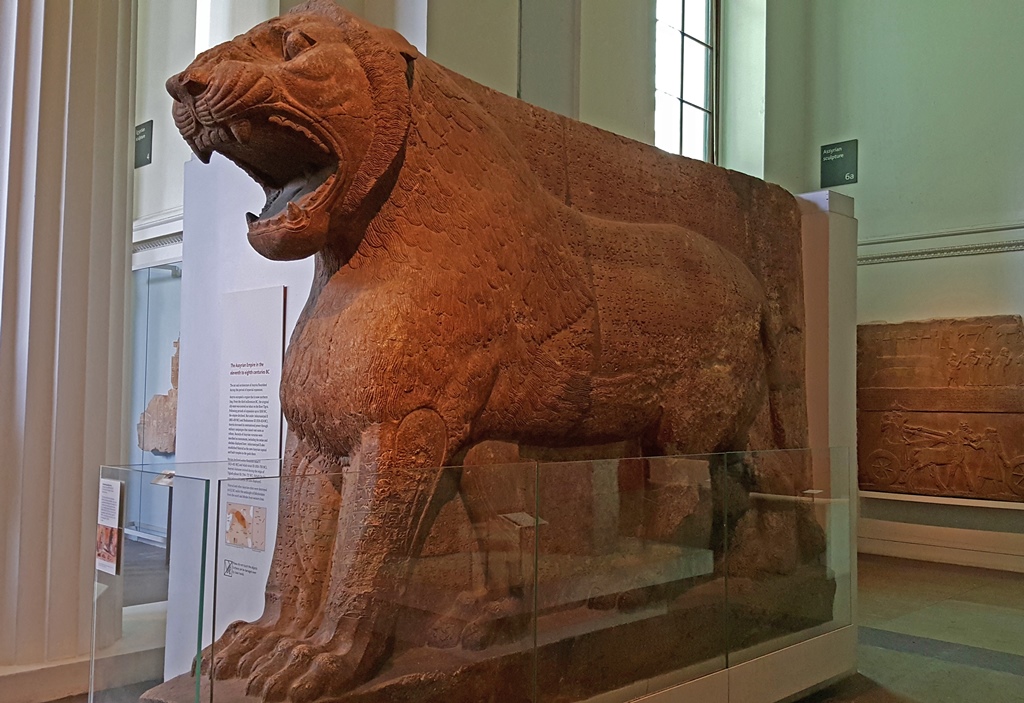
Colossal Guardian Lion, Temple of Ishtar (ca. 865-860 B.C.)
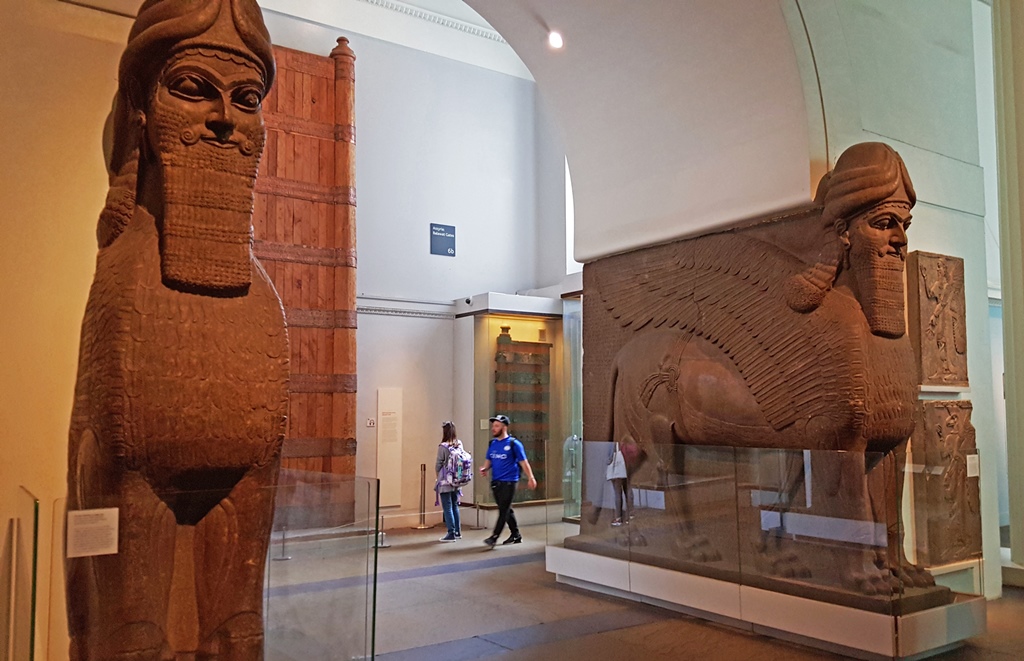
Human-Headed Winged Lions, Nimrud, Assyria (ca. 865-860 B.C.)
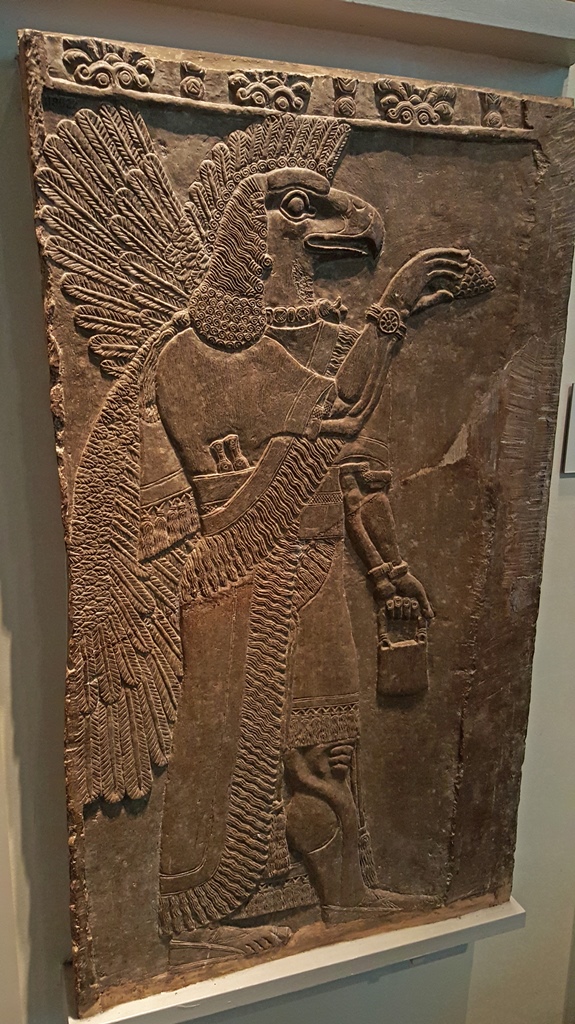
Eagle-Headed Protective Spirit, Temple of Ninurta (ca. 865-860 B.C.)
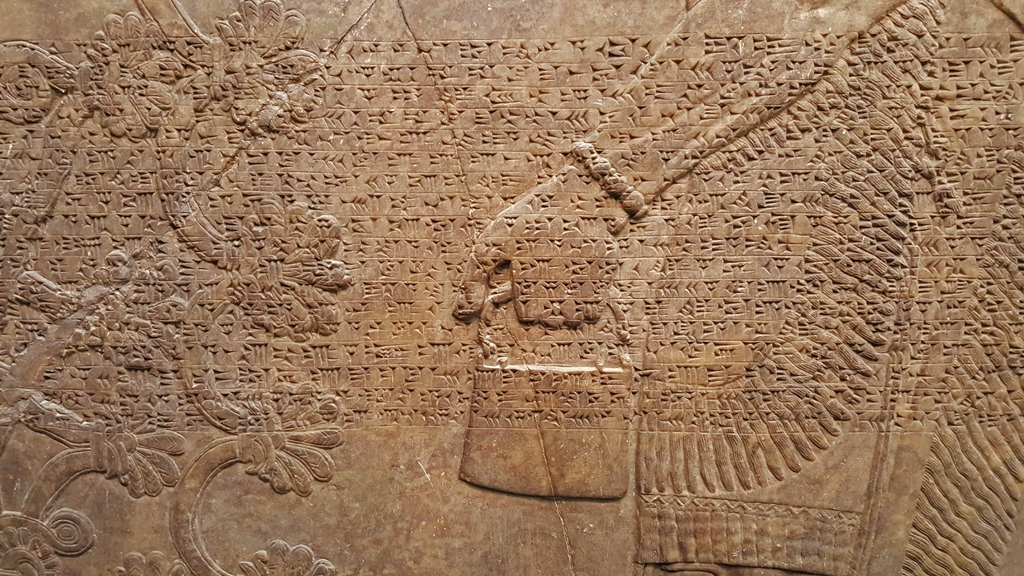
Protective Spirit's Magic Purse with Cuneiform
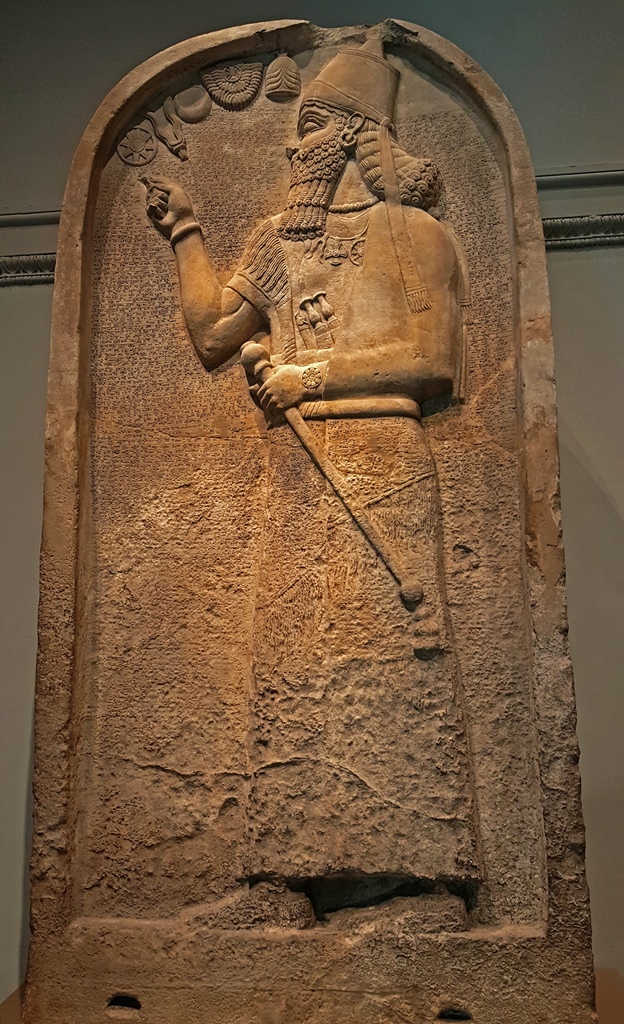
Gypsum Stela of the Assyrian King Ashurnasirpal II, Nimrud (9th C. B.C.)
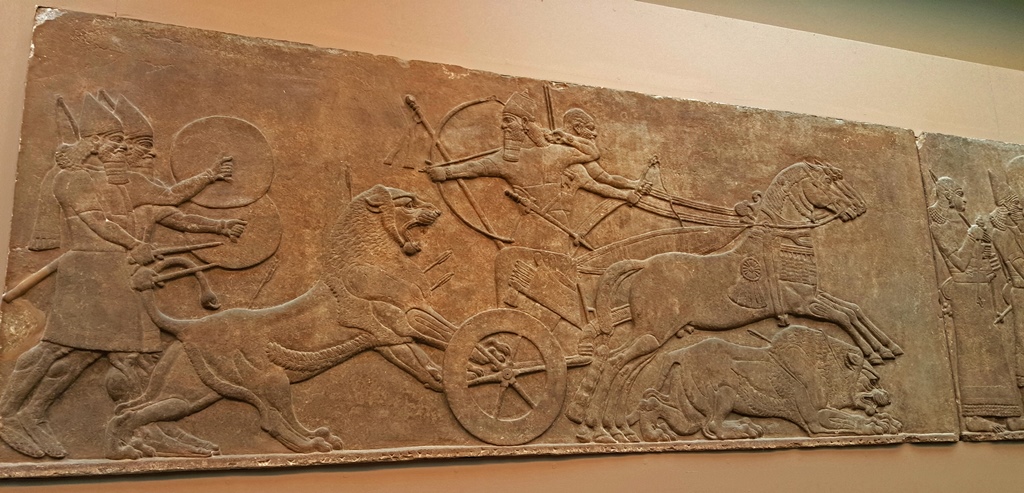
Lion Hunt, Nimrud (ca. 865-860 B.C.)
From here we moved through some rooms with objects found in modern-day Turkey. First,
we found a room holding a reconstructed Nereid Monument from the city of Xanthos.
Nereids are sea nymph daughters of the god Nereus, and the construction of the
Nereid statues reflects a strong Greek influence (and may have been done by Greek
sculptors). The monument was built by the Lykian people, members of a civilization
that was virtually unknown until these artifacts were discovered between 1838 and 1844.
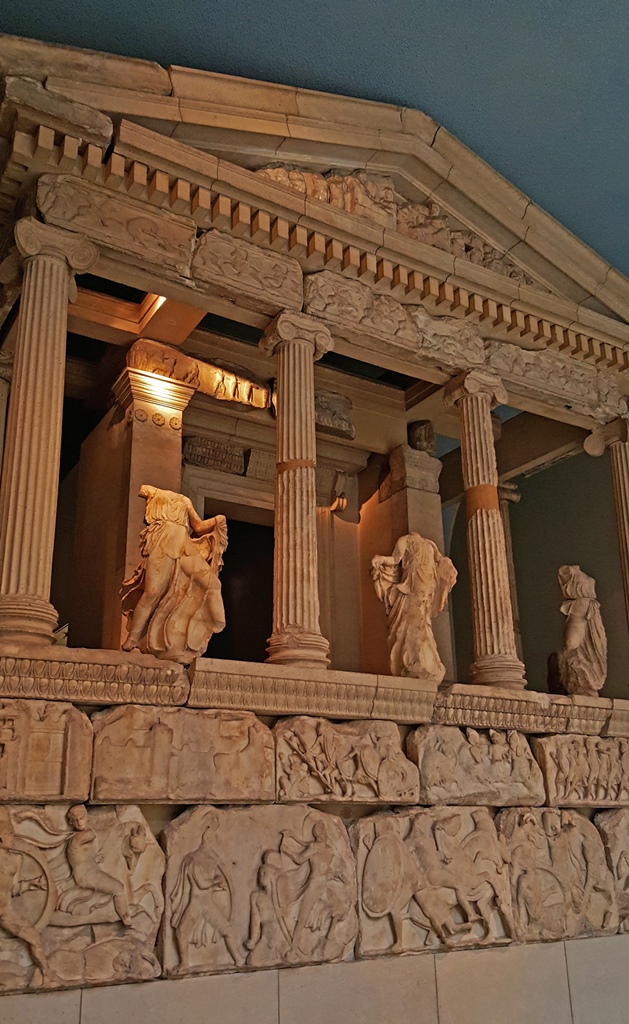
Nereid Monument, Xanthos, Turkey (ca. 390-380 B.C.)
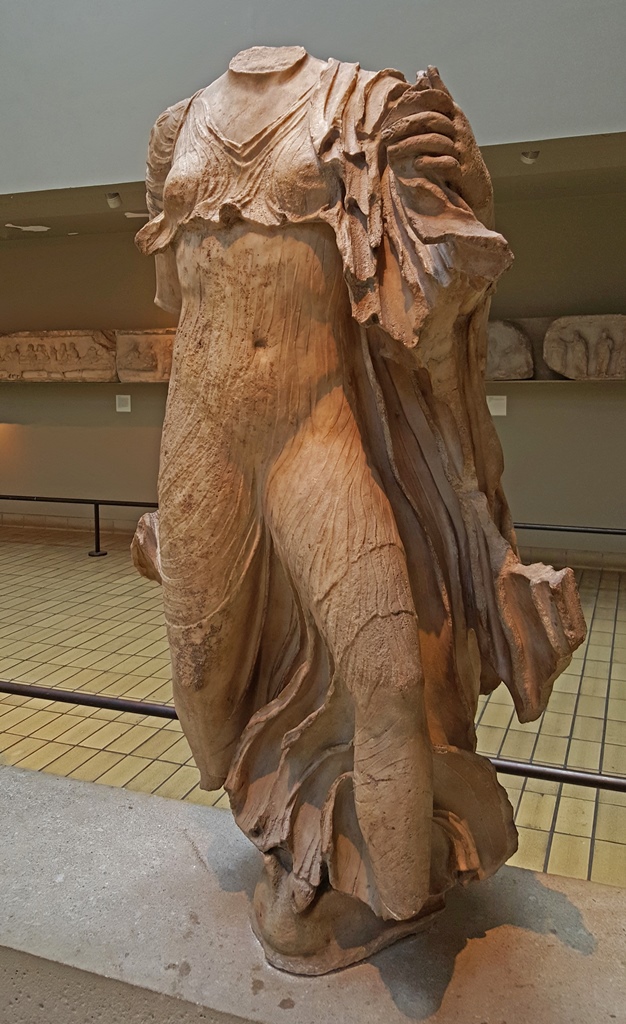
Nereid from the Nereid Monument
Next we found a room with some remains from one of the Seven Wonders of the Ancient
World, the Mausoleum at Halikarnassos. The Mausoleum was built around 350 B.C. as a
tomb for Maussollos, governor of Karia in southwest Asia Minor, which was then part
of the Persian Empire. When intact, the Mausoleum was 140 feet high and had a
pyramid-shaped roof with a four-horse chariot group (or quadriga) at the top.
There was a frieze running around the base depicting a battle between Greeks and
Amazons.
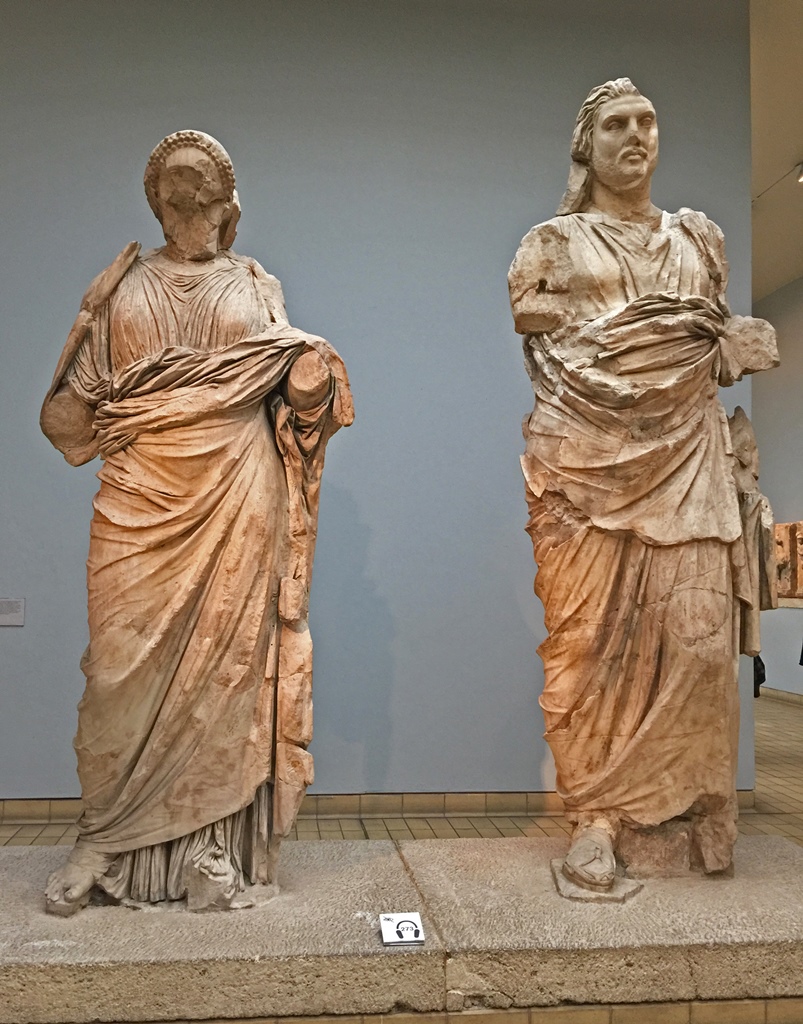
Maussollos and His Wife Artemisia
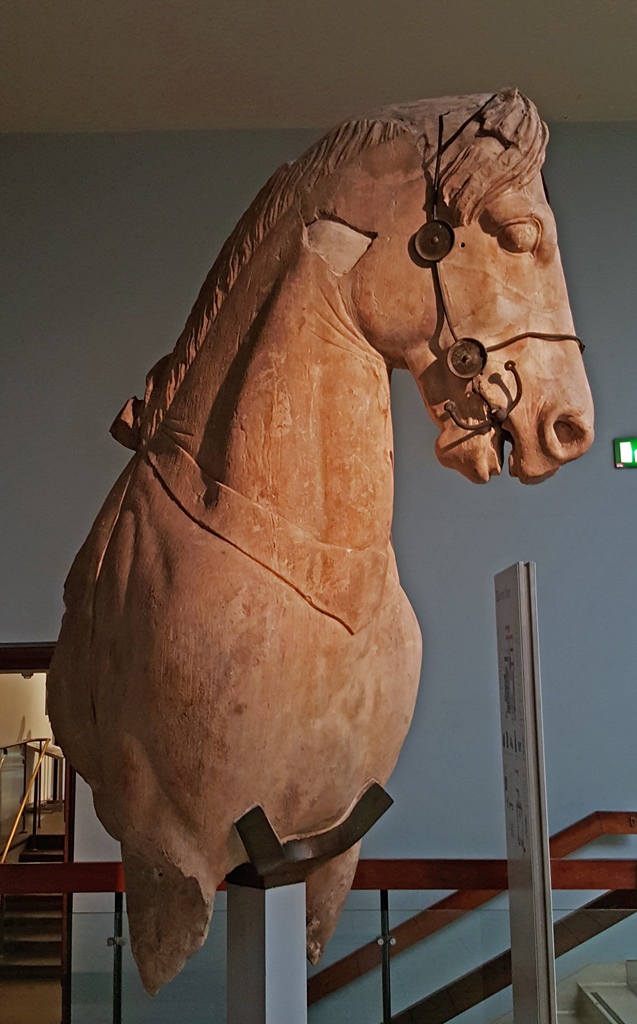
Horse from Quadriga
Frieze Scene of Battle Between Greeks and Amazons
The museum also has artifacts from other parts of Asia Minor, from around the same period:
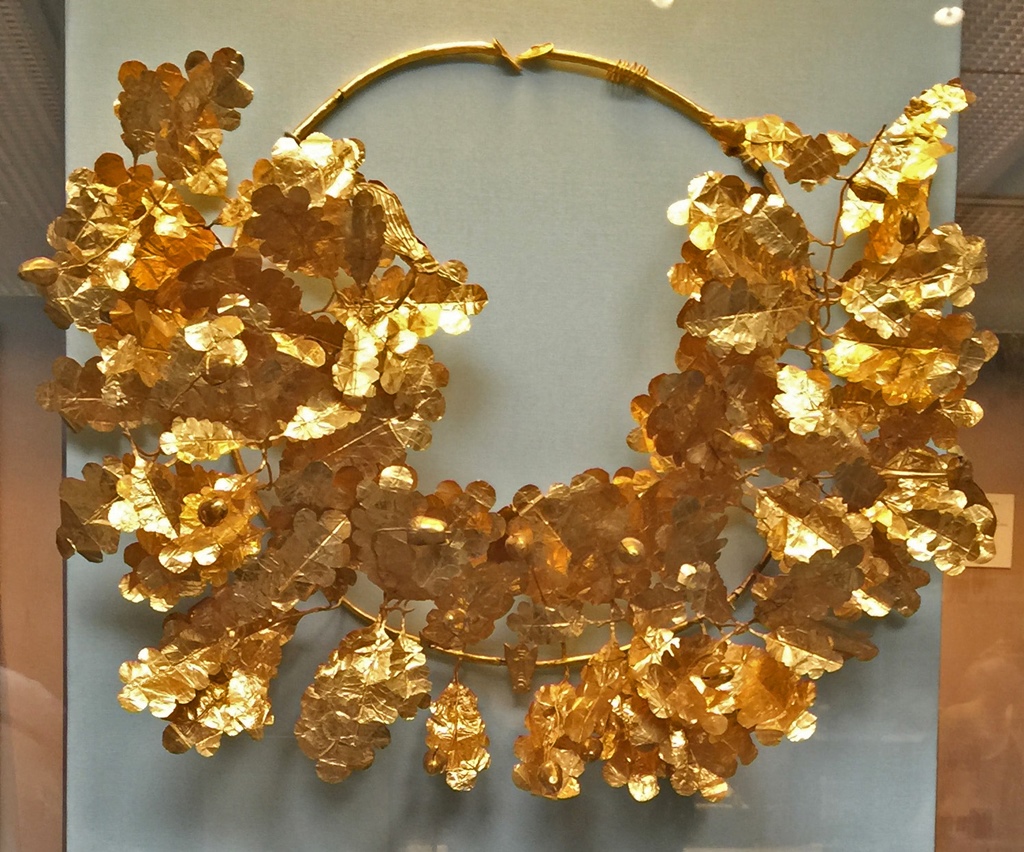
Gold Oak Wreath, Dardanelles (350-300 B.C.)
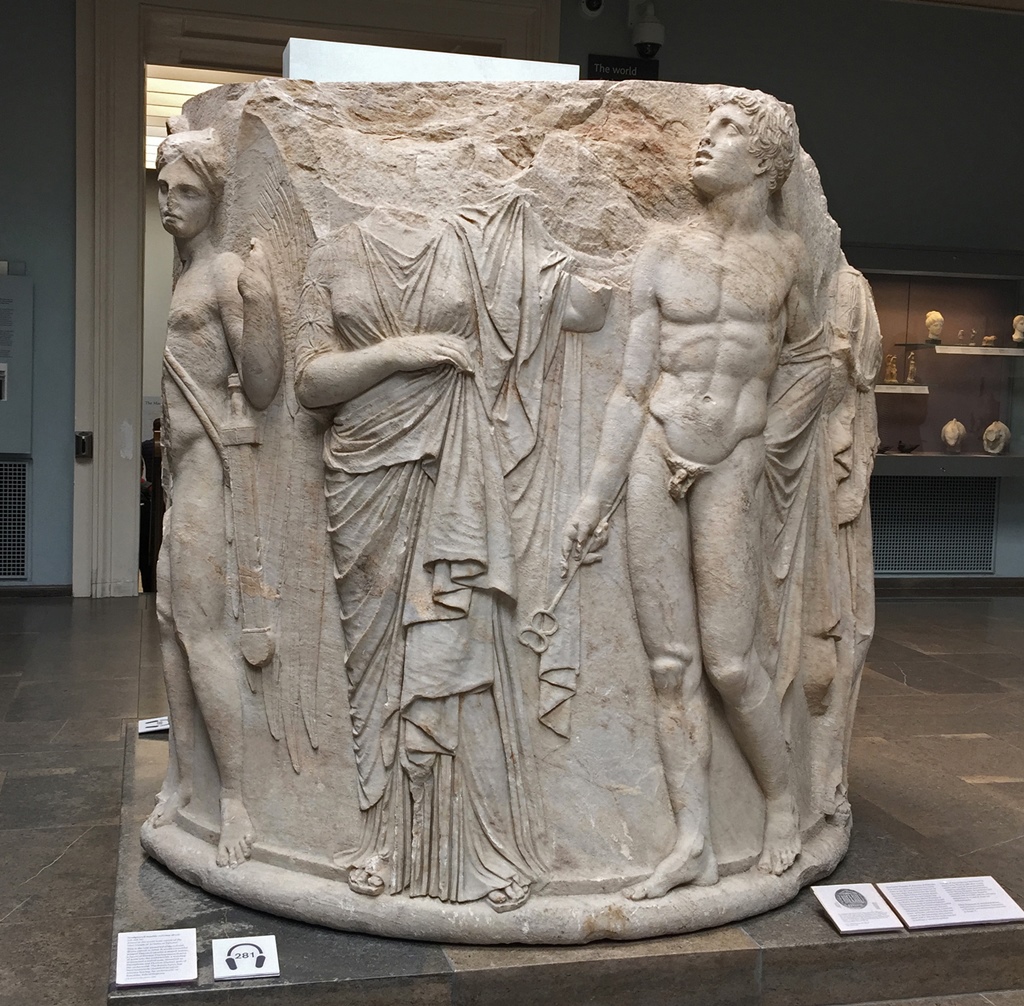
Sculptured Marble Column Drum, Ephesos (325-300 B.C.)
We didn't see too much in the way of Roman artifacts, but we did see this interesting 4th
Century drinking vessel, known as the Lycurgus Cup. This is a cup known as a "cage cup",
which means that it started as a plain glass cup, but its surface was ground back
selectively to leave a surface-level design. In this case, the design depicts the mythical
King Lycurgus being ensnared by a vine into which a follower of Dionysus had been
transformed (the unfortunate king did not survive the encounter). A couple of things set
this cup apart from other cage cups. First, most cage cups were decorated with geometric
designs, and this is the best-preserved cage cup known to exist which depicts actual
figures. Second, the cup is made of something called "dichroic glass", which appears green
when lit from the front, but red when light is shown through it.
The Lycurgus Cup, Rome or Alexandria (4th C. A.D.)
This brought us to what is possibly the most famous of the museum's possessions and
almost certainly its most controversial, this being the Parthenon Marbles, otherwise
known as the Elgin Marbles. The Parthenon, of course, is the large temple to Athena
which is found on top of a hill called the Acropolis in Athens, Greece. The Parthenon
was built from 447-432 B.C. at the direction of Pericles, the great general and ruler
of Athens. There was plenty of space for a temple, as the Persians under Xerxes I had
sacked the city and destroyed everything on top of the Acropolis in 480 B.C.
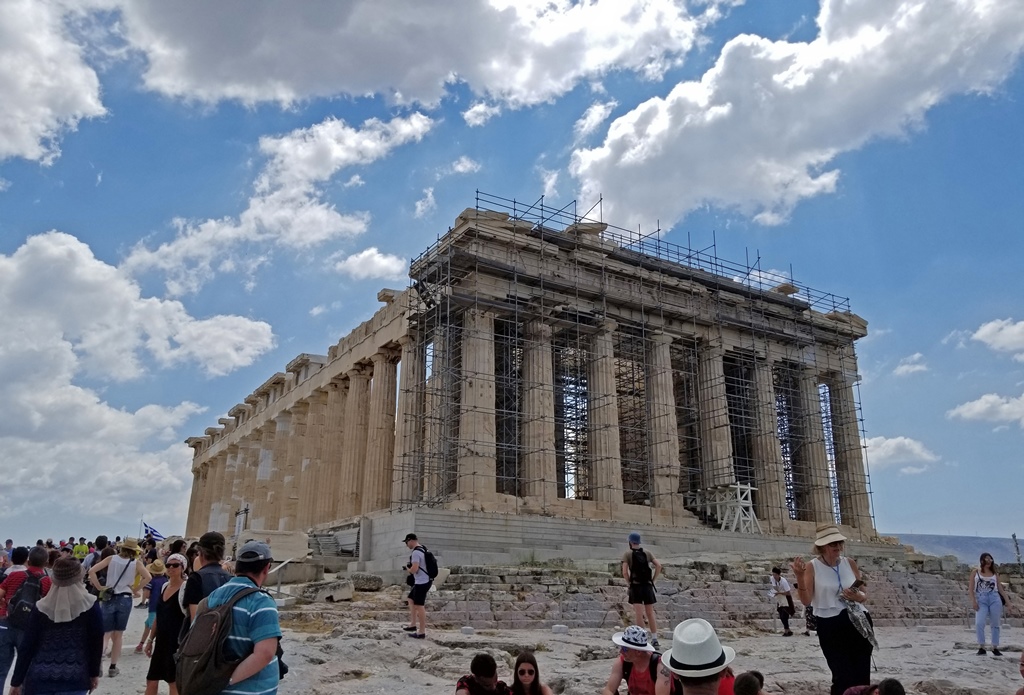
The Parthenon (2019)
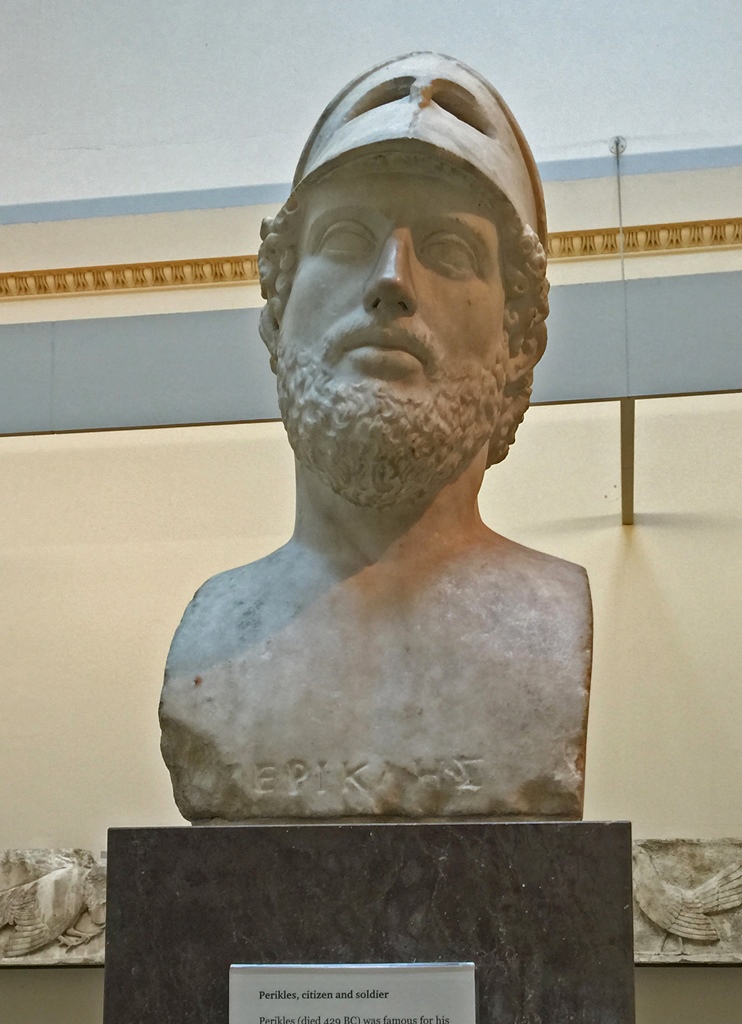
Bust of Pericles, Roman Copy (2nd C. A.D.)
The Parthenon is 228 feet long, 101 feet wide and 45 feet tall, thus presenting a lot of
surface area for decoration. And the best sculptors in Athens decorated with great energy.
The decorations were of three different types. First, sculptures were created for the
pediments, the triangular areas at the top of each end of the temple. Second, sculpted
panels called metopes were lined up just under the edge of the roof, with 92 metopes
stretching all the way around the temple. And third, there was a frieze which extended
around the cella, which was a smaller structure (98 feet by 68 feet) located within
the temple.
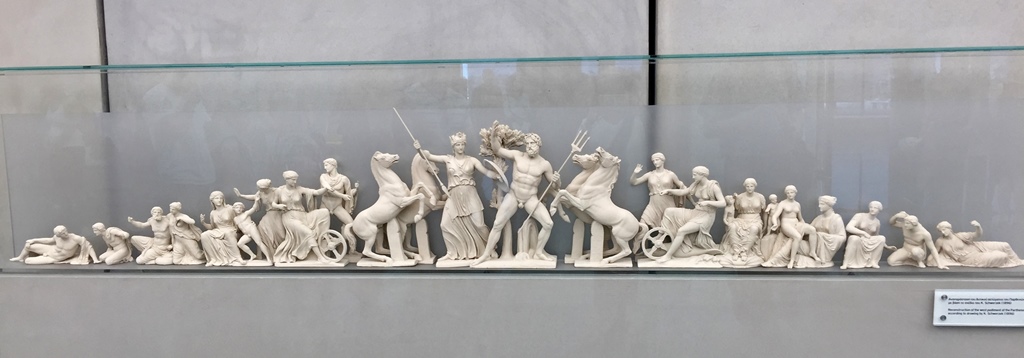
Reconstruction of West Pediment Sculptures
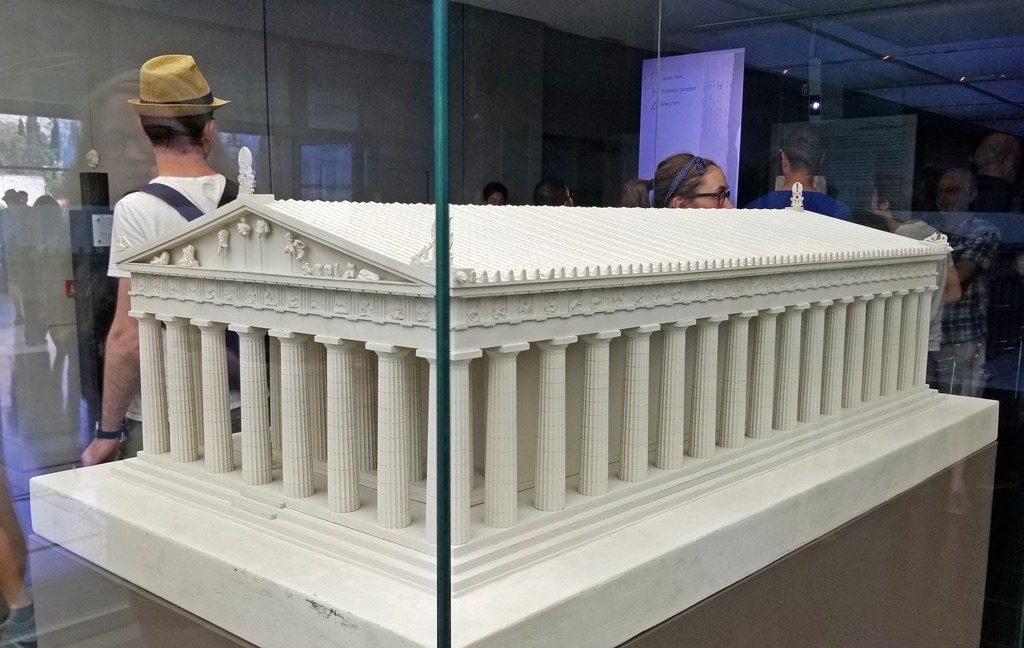
Model of Parthenon, Showing Location of Metopes
Over the centuries, the Parthenon became a Christian church, and later, after the conquest of
Greece by the Ottoman Turks, the Parthenon became a mosque. In 1687, the Turks were using the
Acropolis as a defensive fortification during a war against the Venetian Republic, and they
used the Parthenon as a powder magazine. A Venetian artillery round struck the magazine and
ignited a blast that killed 300 people, while causing catastrophic damage to the Parthenon.
The central part of the building was essentially destroyed, with the loss of the roof and the
collapse of three of the four walls of the cella. Venetian soldiers looted some of the
sculptures, and over the following century, many additional pieces of the structure were looted
by locals for building material.
In 1801, Thomas Bruce, 7th Earl of Elgin and British Ambassador to the Sultan of Turkey
undertook the task of making drawings and plaster casts of the surviving sculptural elements
found on the Acropolis. Later that year, he started removing sculptural elements from the
Parthenon wreckage and from other structures on the hill and sending them back to England. By
the time he finished, in 1812, he had taken more than half of the surviving structural
elements from the Parthenon, including 21 figures from the pediments, 15 metope panels and
nearly 250 feet of the cella frieze. In 1816, Lord Elgin ended up selling the marbles to the
British government, for about half of what he'd spent to acquire them.
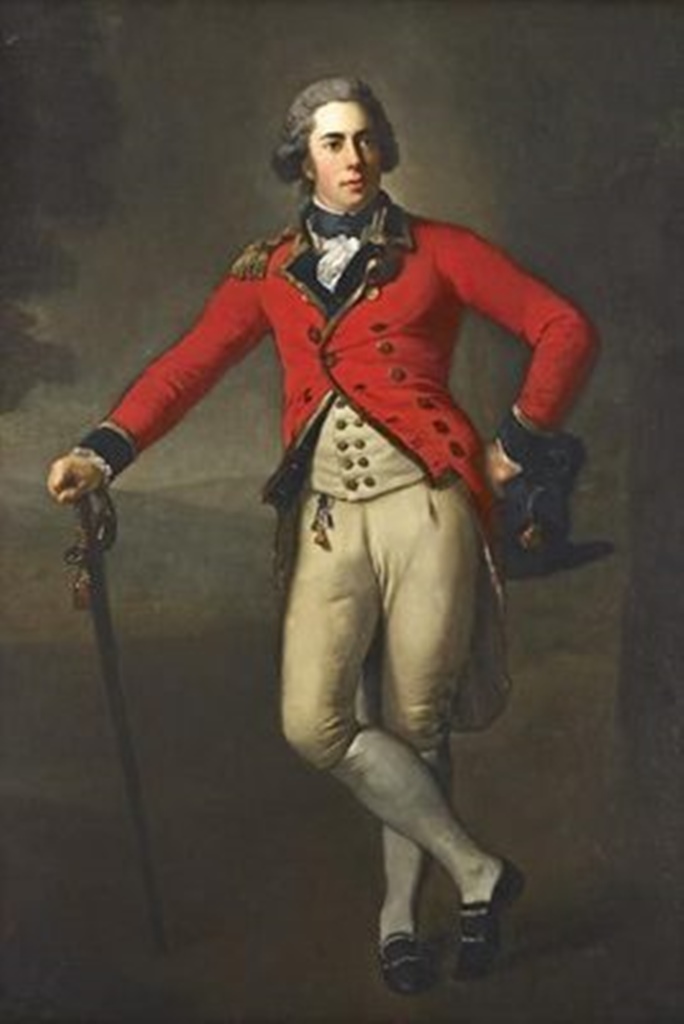
Thomas Bruce, 7th Earl of Elgin (1788)
In 1832, Greece gained independence from the Ottoman Empire and started tracking down
antiquities that had been looted and dispersed to various other countries around the world.
High on their list were the Elgin Marbles, by this time on display at the British Museum. But
the British Museum refused to return the marbles, maintaining that they'd been legitimately
acquired, and that they were now an integral part of the museum's collection. They said that
the Sultan at the time, Selim III, had been grateful for Britain's opposition to the
expansionist activities of Napoleon, and that the marbles weren't of any particular value to
him, so he'd signed a decree giving Lord Elgin permission to remove whatever material he
wished. But no such decree has ever been found, which is suspicious, considering the Turks
were normally meticulous record-keepers.
And this is pretty much how things stand to the present day. The Greeks would very much like
to have the marbles back, and even have spaces reserved for them in their recently-built,
state-of-the-art Acropolis Museum. The British Museum insists that they (or their distant
predecessors, to be more precise) behaved honorably throughout the acquisition of the marbles
and the dispute over them, and that if they started returning items in their collection to
their countries of origin, they would soon have no collection left. So the Parthenon Marbles
continue to reside at the British Museum, in a room called the Duveen Gallery, which was
specifically built for them in the 1930's. Here's the gallery, and figures from the
Parthenon pediments:
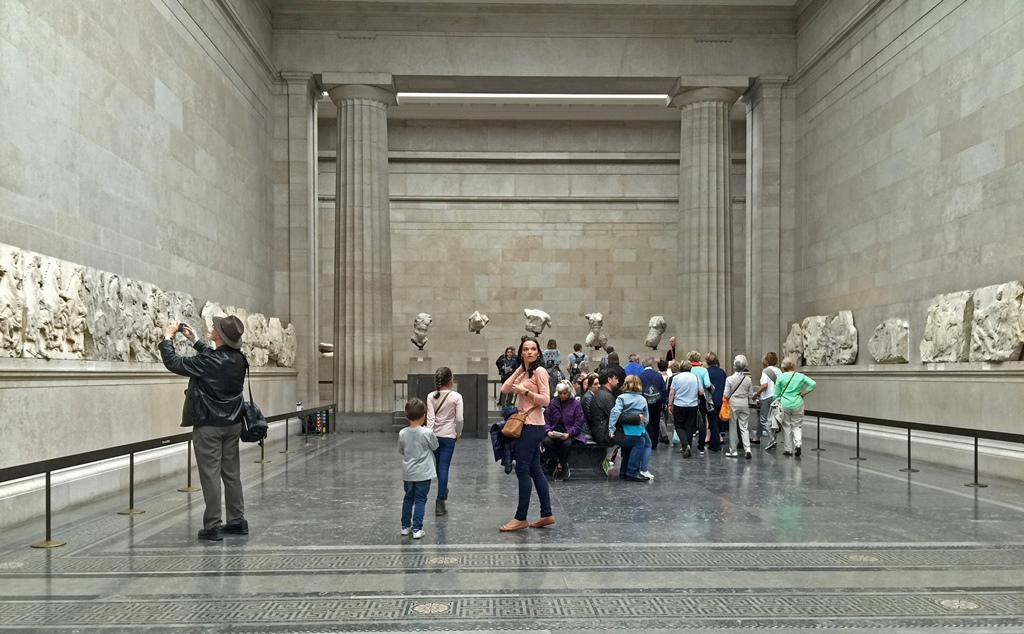
Duveen Gallery with the Parthenon Marbles
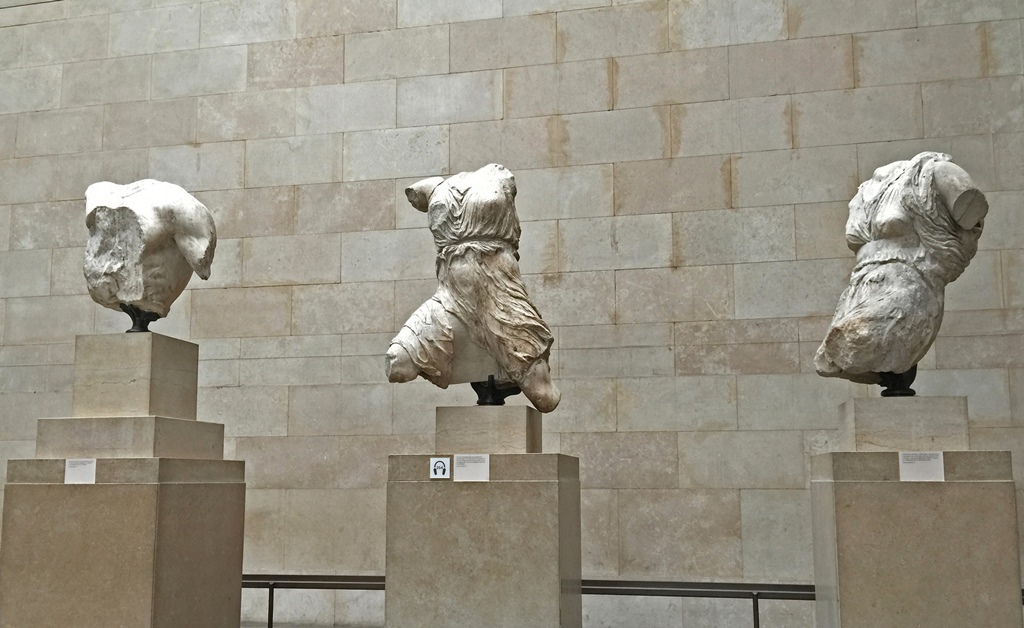
Figures from the West Pediment
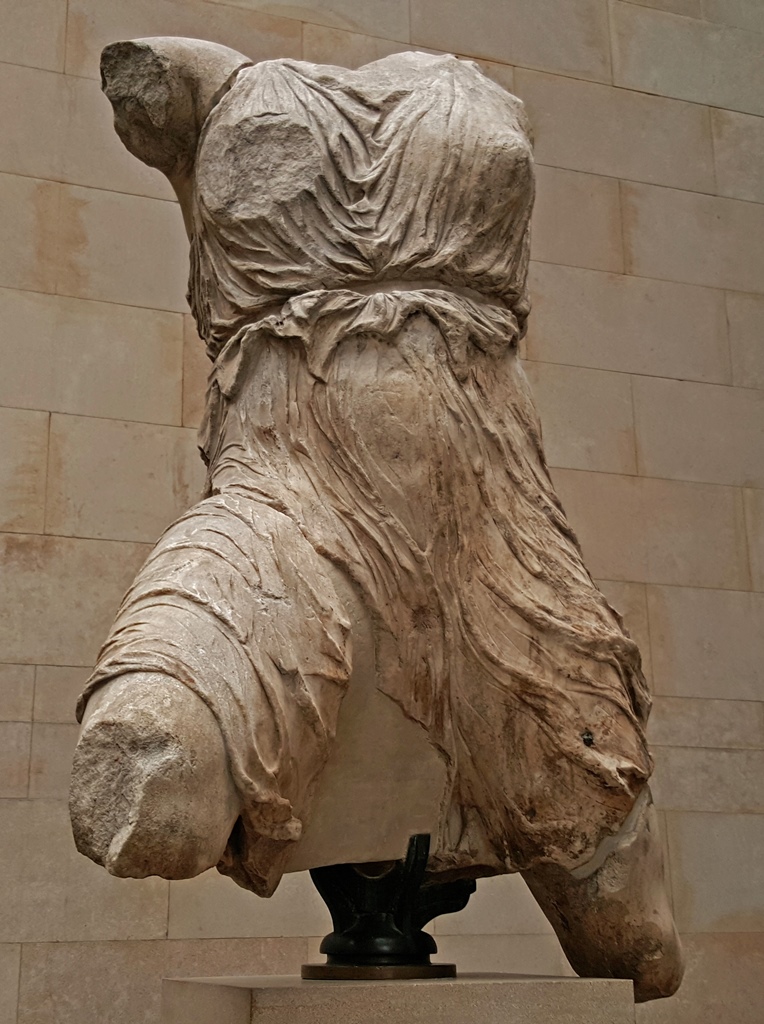
Figure of Iris, West Pediment
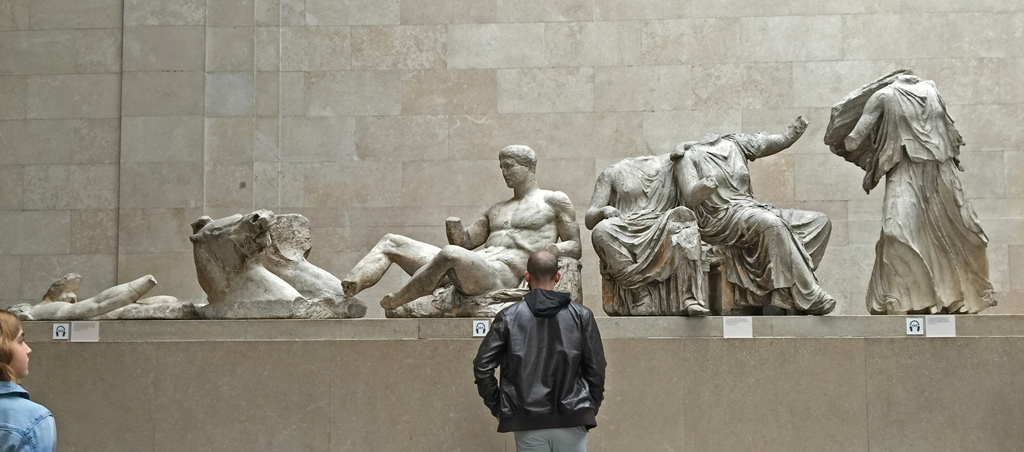
Figures from East Pediment
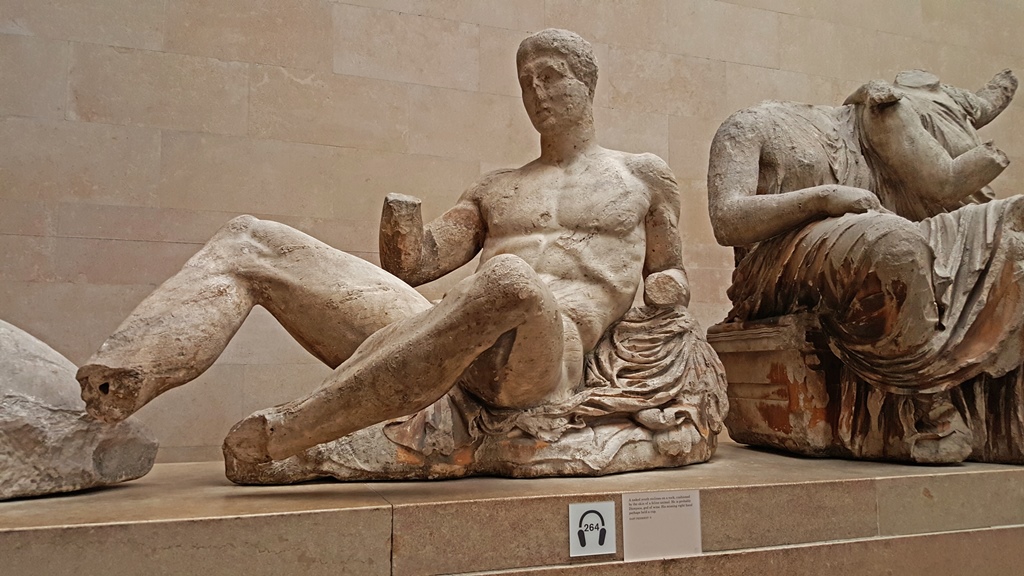
Reclining Dionysos, East Pediment
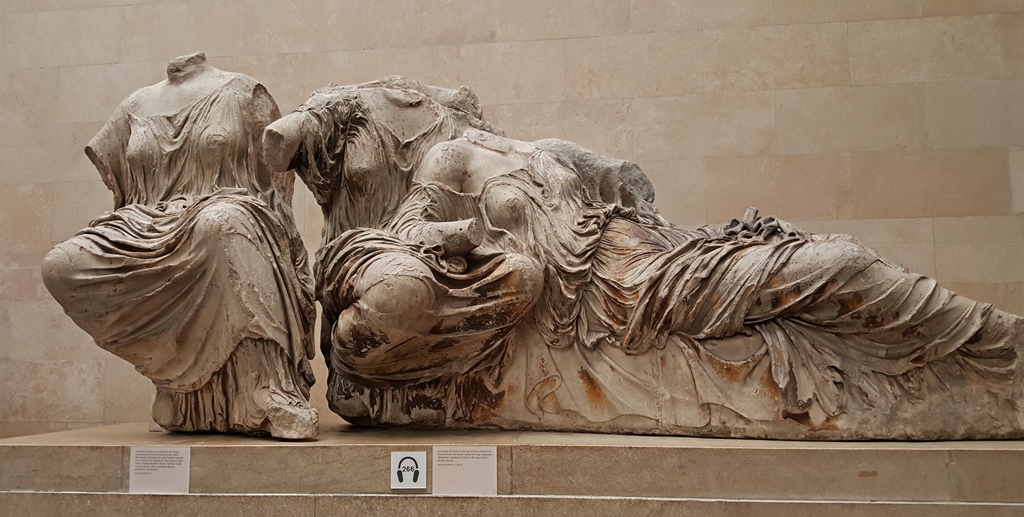
Hestia, Aphrodite and Dione, East Pediment
All of the recovered metopes appear to have come from the south side of the temple, and
they all depict a battle between Lapiths (a legendary tribe from Thessaly) and centaurs.
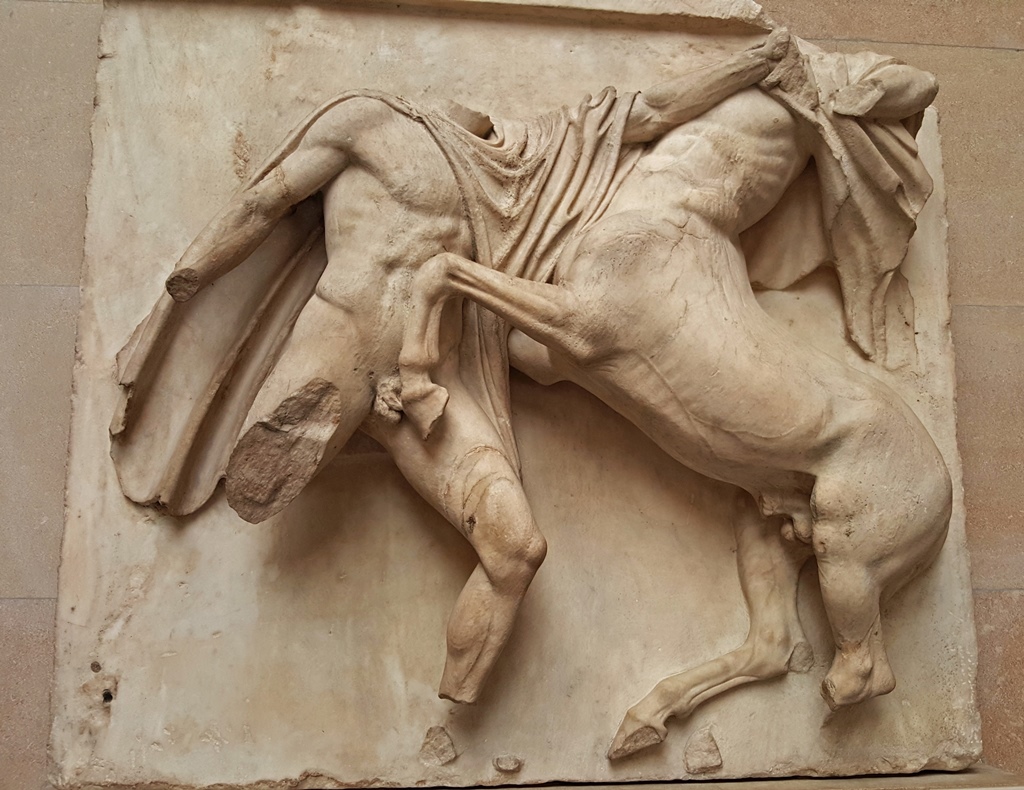
Lapith Fighting with Centaur
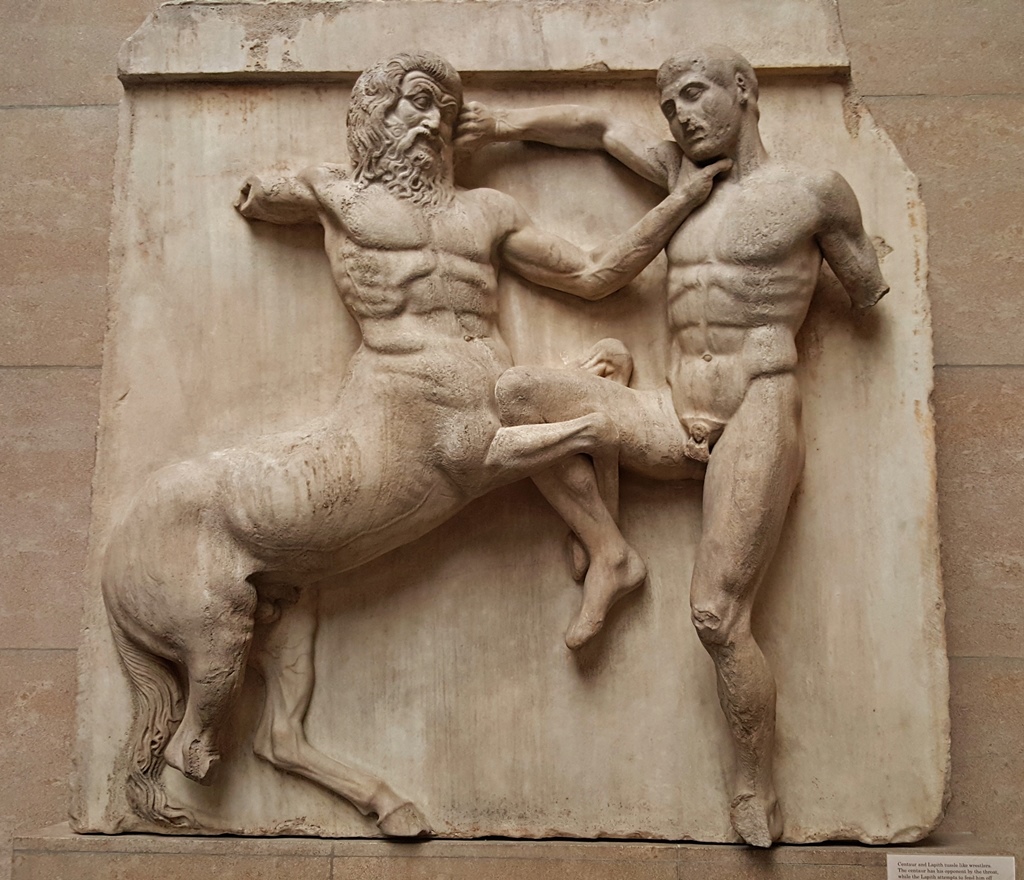
Lapith Fighting with Centaur
Centaur Carrying Off Girl
The surviving frieze sections depict a thanksgiving procession following a successful battle.
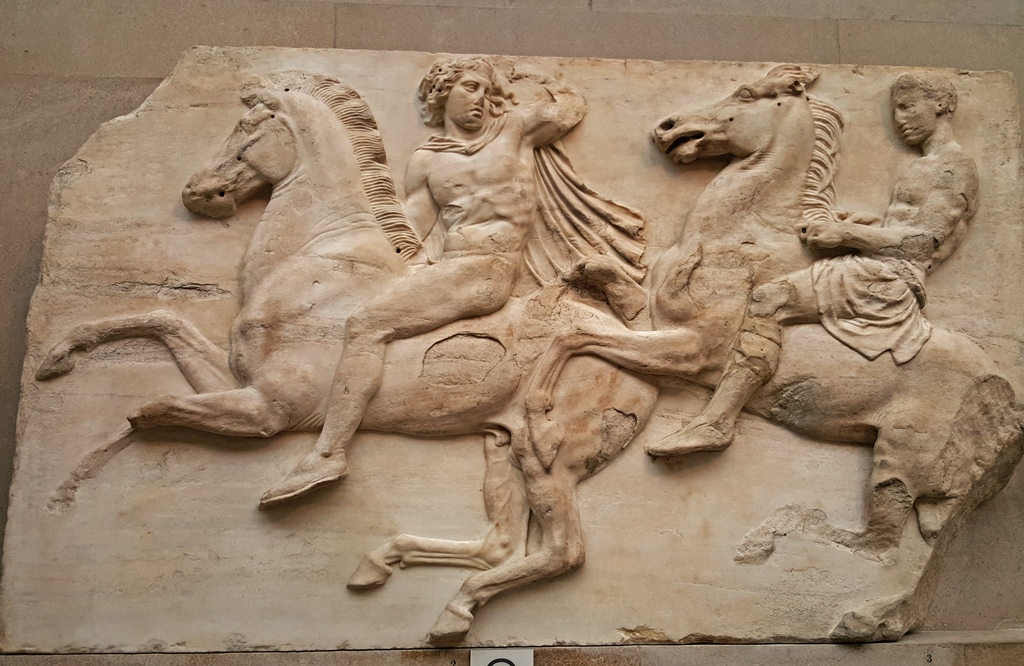
Horsemen, South Frieze
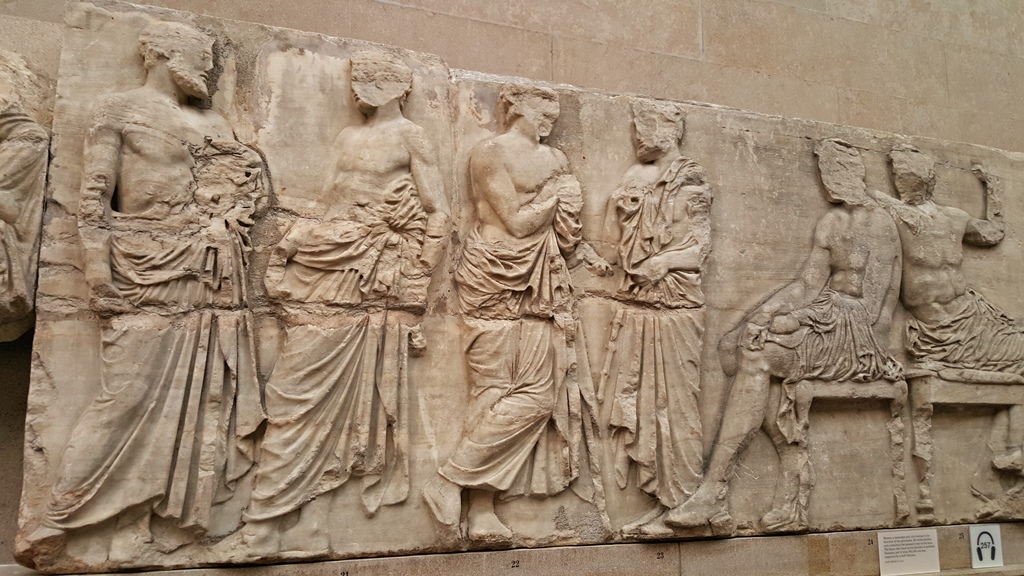
Portion of East Frieze with Hermes and Dionysos
This seemed like a good time to move on to another part of the world, like all the way
to the South Pacific and Easter Island.
Basalt Figure from Easter Island
Well, maybe not that far. Maybe just to Asia, and Burma (present-day Myanmar):
Lidded Offering Vessel, Burma (19th C.)
Here are some ceramic figures from different eras of Chinese history:
Tomb-Figures, North China (8th C.)
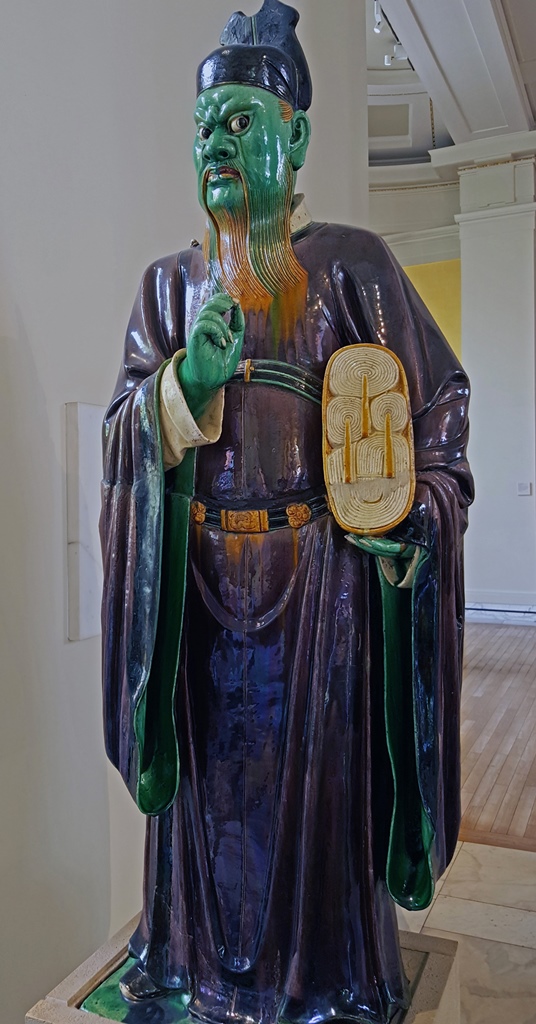
Figure from a Judgement Group, Ming Dynasty (16th C.)
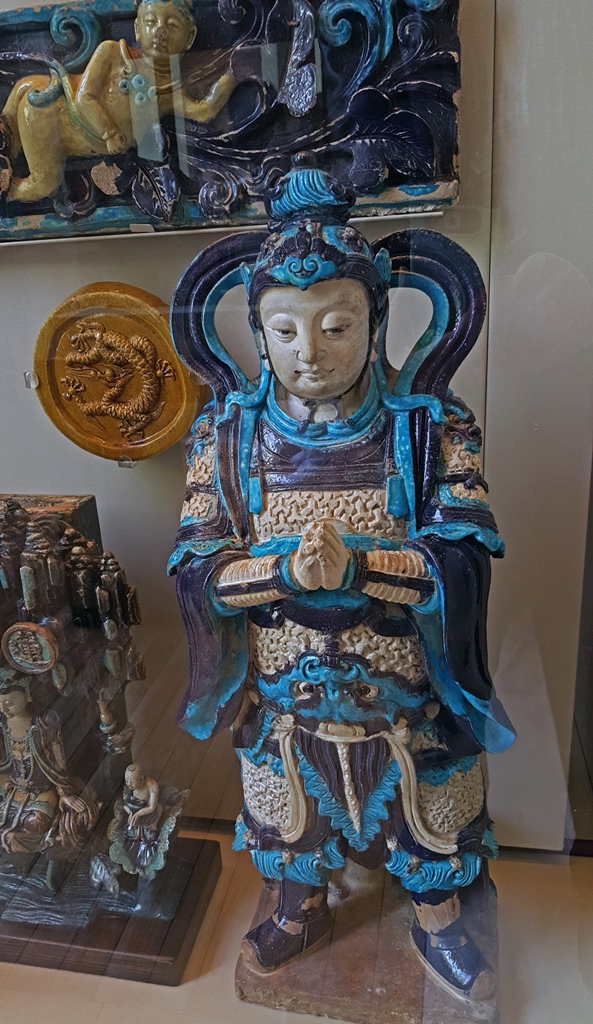
Standing Military Figure, Ming Dynasty (1626)
Here's a sculpture from early 19th Century Tibet:
Yamantaka Vajrabhairava (Buddhist Deity), Tibet (19th C.)
Moving over to Japan, here's a wooden sculpture of Monju Bosatsu. But it's possible that
you don't know who Monju Bosatsu is. I have to admit I had to look this up. Sources
tell me that Monju Bosatsu is a Bodhisattva. This didn't really clear things up for me,
but it turns out that a Bodhisattva is an enlightened Buddhist being that goes around
between rebirth cycles helping people. Monju Bosatsu embodies the Buddha's wisdom, and
has a flaming sword that cuts through ignorance. He also rides on a lion that roars with
the sound of Buddhist law. Not to upset any Buddhists out there, but Monju Bosatsu sounds
a little on the cartoony side. Not that that's necessarily uncool...
Monju Bosatsu, Koyo (1685-89)
Moving back to India, here are a couple of items from the museum's Indian collection. FYI, Shiva
and Parvati are Hindu deities that are married to each other.
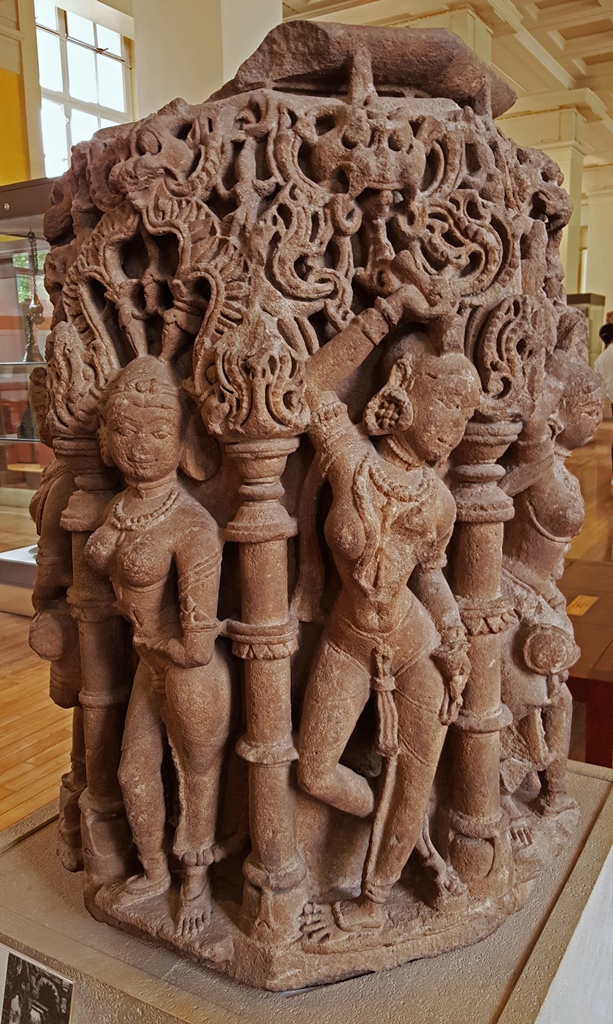
Column Base, Western India (11th C.)
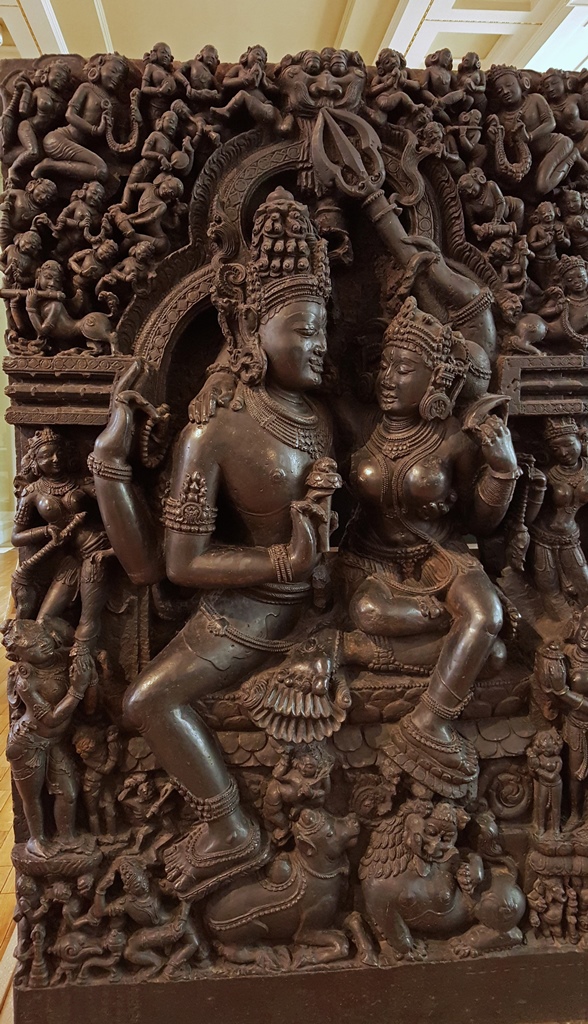
Shiva and Parvati, India (12th-13th C.)
From the Asian displays, we walked across the central courtyard of the museum to the
Enlightenment Gallery. This is in the east wing of the building and is its oldest
room, with a room number of 1. It was originally designed to hold the Library of
George III, which stayed here (with a couple of temporary moves during the world wars
for its protection) until it was moved to the new British Library in 1997. The room
is now devoted to the Age of Enlightenment (also known as the Age of Reason), which
lasted roughly from 1680 until 1820, when people were energetically trying to figure
out the world around them, in the process collecting numerous natural and archaeological
specimens and writing scholarly books about them or speculating about them. A number
of these objects are on display, along with very brief or frequently nonexistent
descriptions.
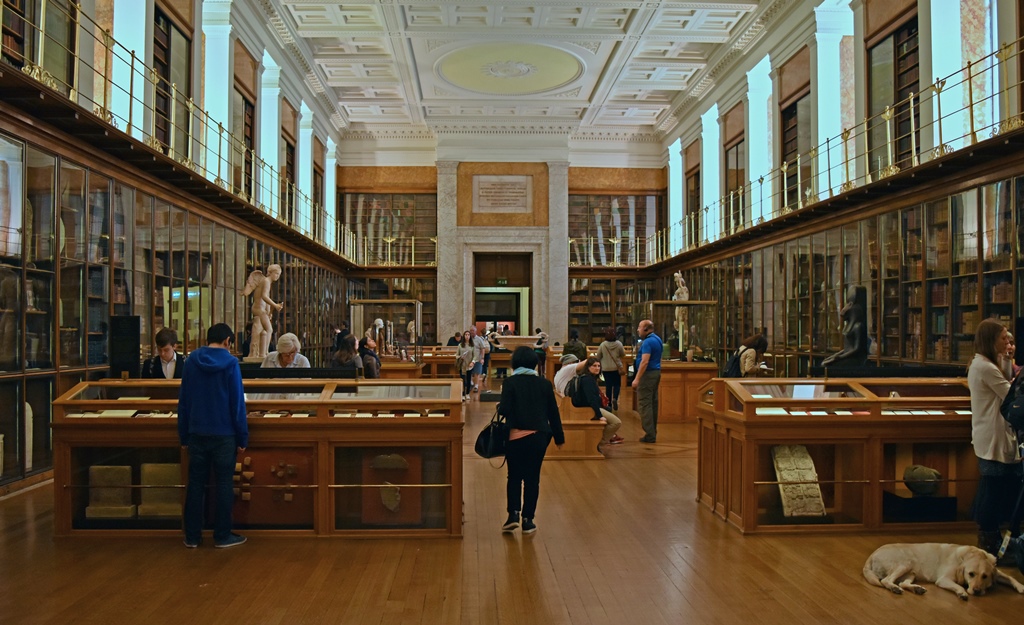
Nella in Enlightenment Gallery
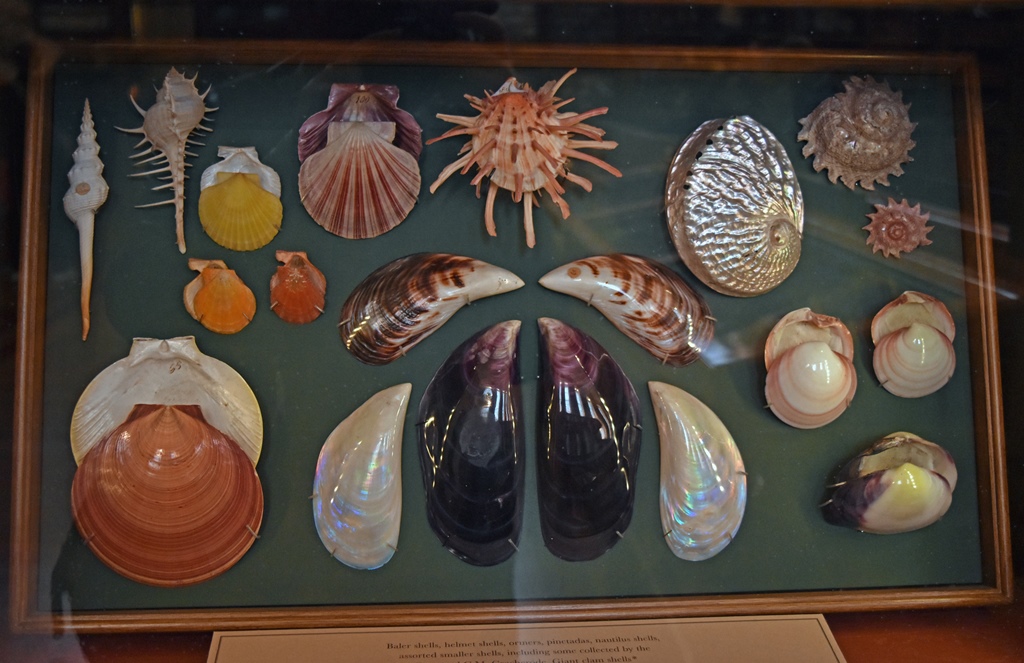
Seashell Collection
Adjacent to the Enlightenment Gallery, also in the east wing, is a room in which the
Waddesdon Bequest is displayed. This collection was bequeathed to the museum by
Baron Ferdinand Rothschild in 1898, and consists of objects he'd kept in his Smoking
Room at Waddesdon Manor, in Buckinghamshire. There is an impressive amount of metal
and ceramic work in the collection.
Objects from the Waddesdon Bequest
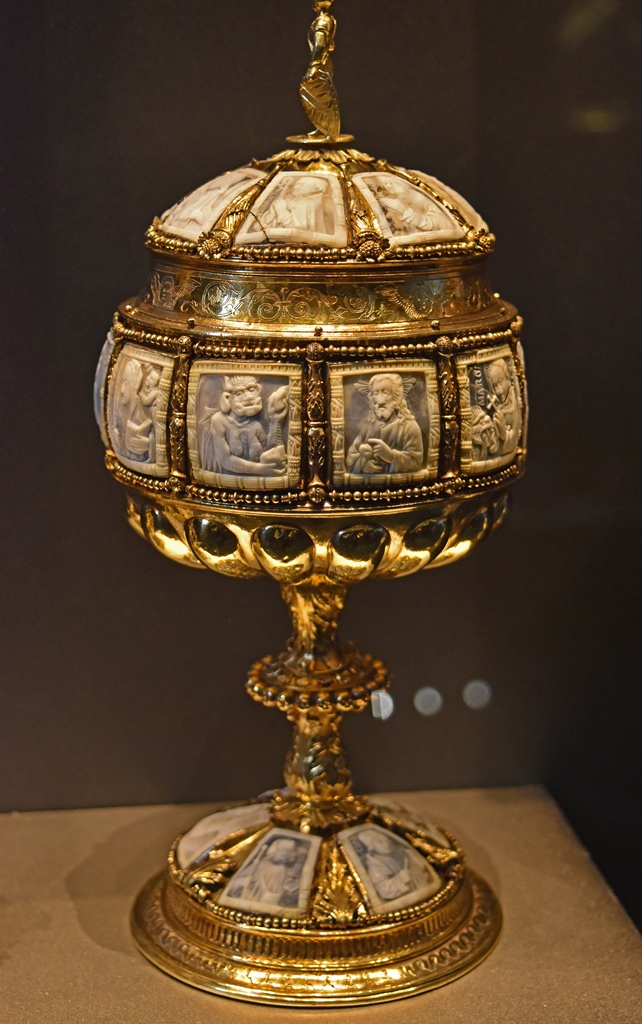
Cup with Shell Cameos, Nuremberg (1525-50)
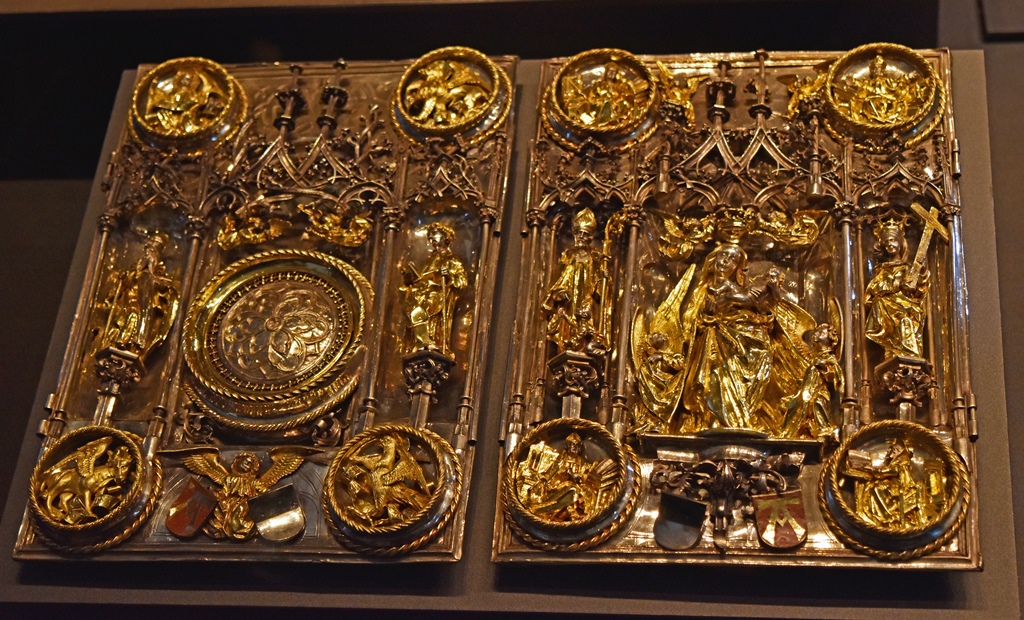
The Ulm Book Covers (ca. 1506)
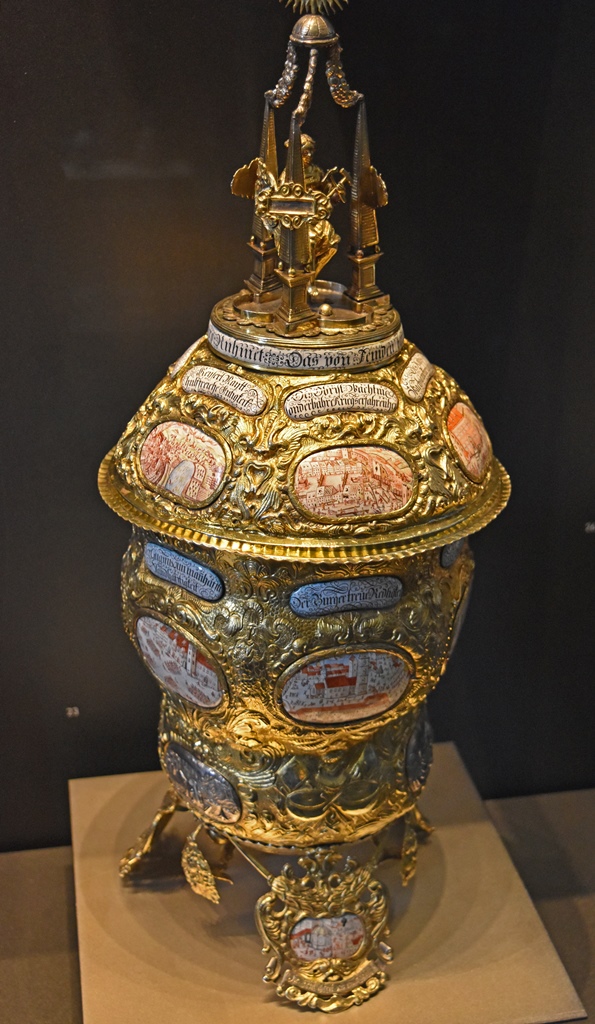
Vase, Saxony (1670)
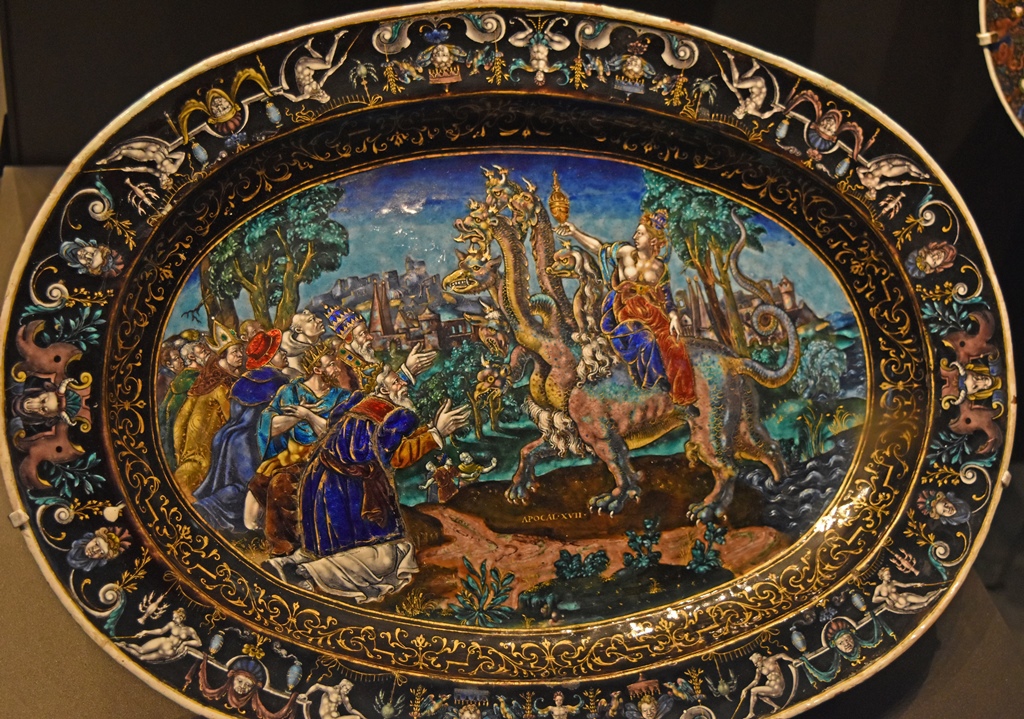
The Woman of the Apocalypse, Limoges (ca. 1570)
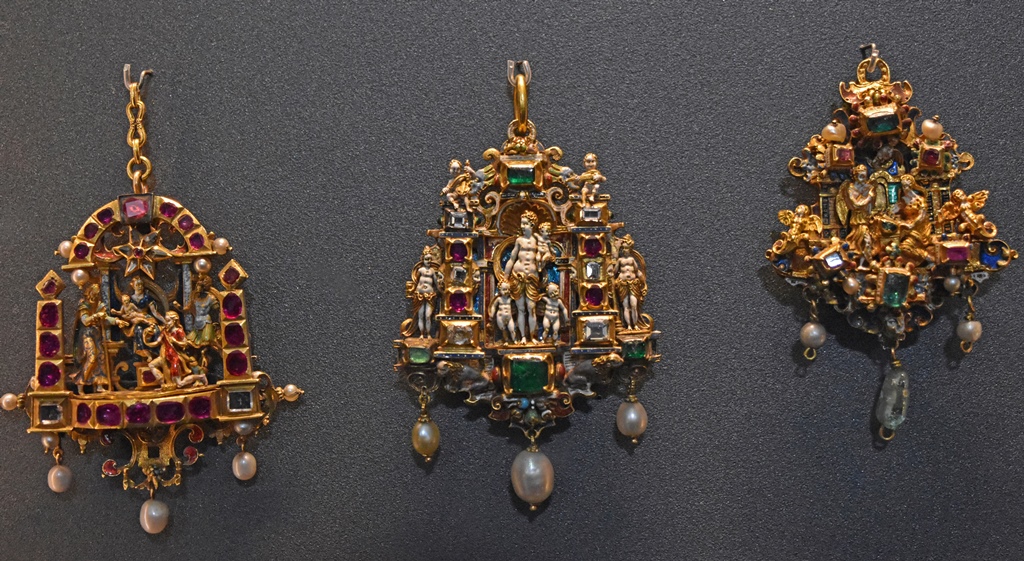
Assorted Pendants
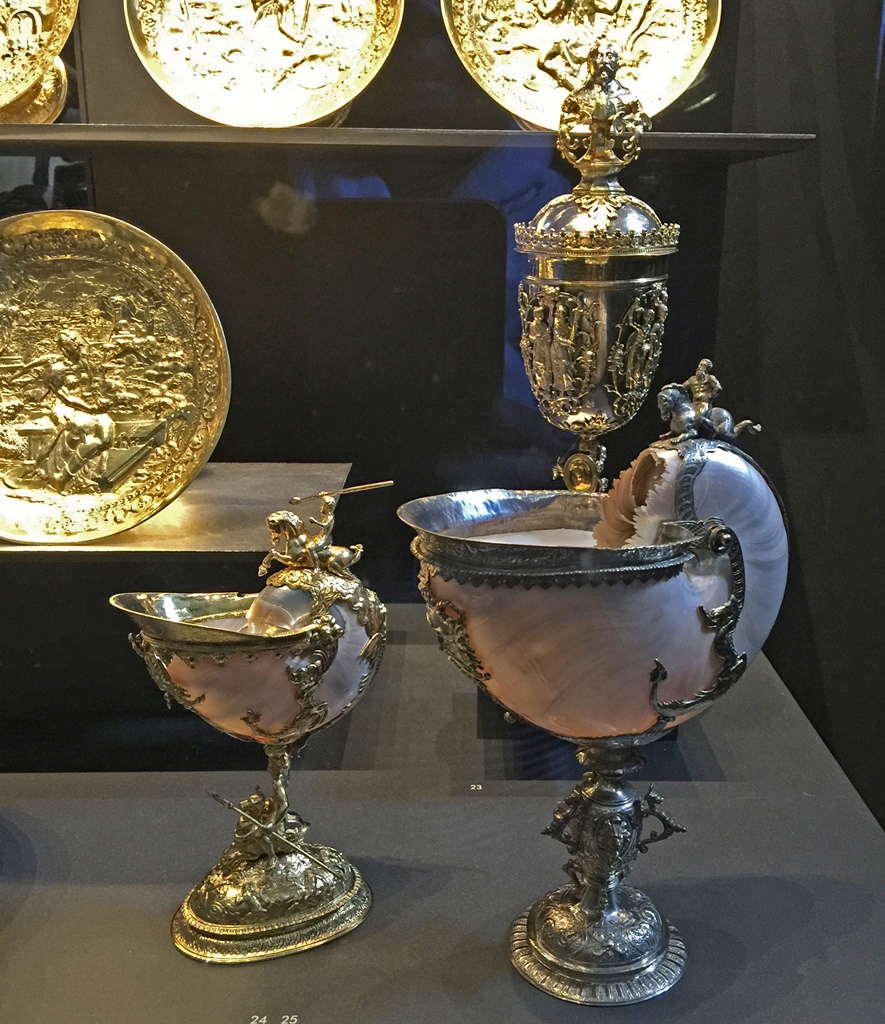
Nautilus Cups, Dutch (1594-1650)
We finally finished with the British Museum, and though there was still much of interest
in London that we hadn't seen, we'd about finished with the city also, as we needed to
prepare for travel the next day. We would be flying from a capital city in western
Europe, where we were (mostly) familiar with the language, to another capital city, but
in eastern Europe, where the language would be quite difficult. We would be embarking
on an adventure to the city of Prague.

